TOP OF THE LIST

From Tar Heel born to national and international players, companies are choosing North Carolina for big expansions.






FEATURE STORY



From Tar Heel born to national and international players, companies are choosing North Carolina for big expansions.









Charlotte and the Triangle are becoming financial technology hubs, with Wilmington also attracting a share of this burgeoning industry.
Eastern North Carolina, a perennial agricultural powerhouse, is turning new leaves. It’s refocusing, expanding and cultivating assets to create a bountiful future.



The Triad and the Carolina Core regions landed the biggest economic development investments in state history last year along with other game-changing employers. Its educational resources and labor force, notably in aerospace, are two of many key factors.








Western North Carolina is a top tourist destination that is also becoming more popular for business relocations because of its quality of life, educational support and improving infrastructure.


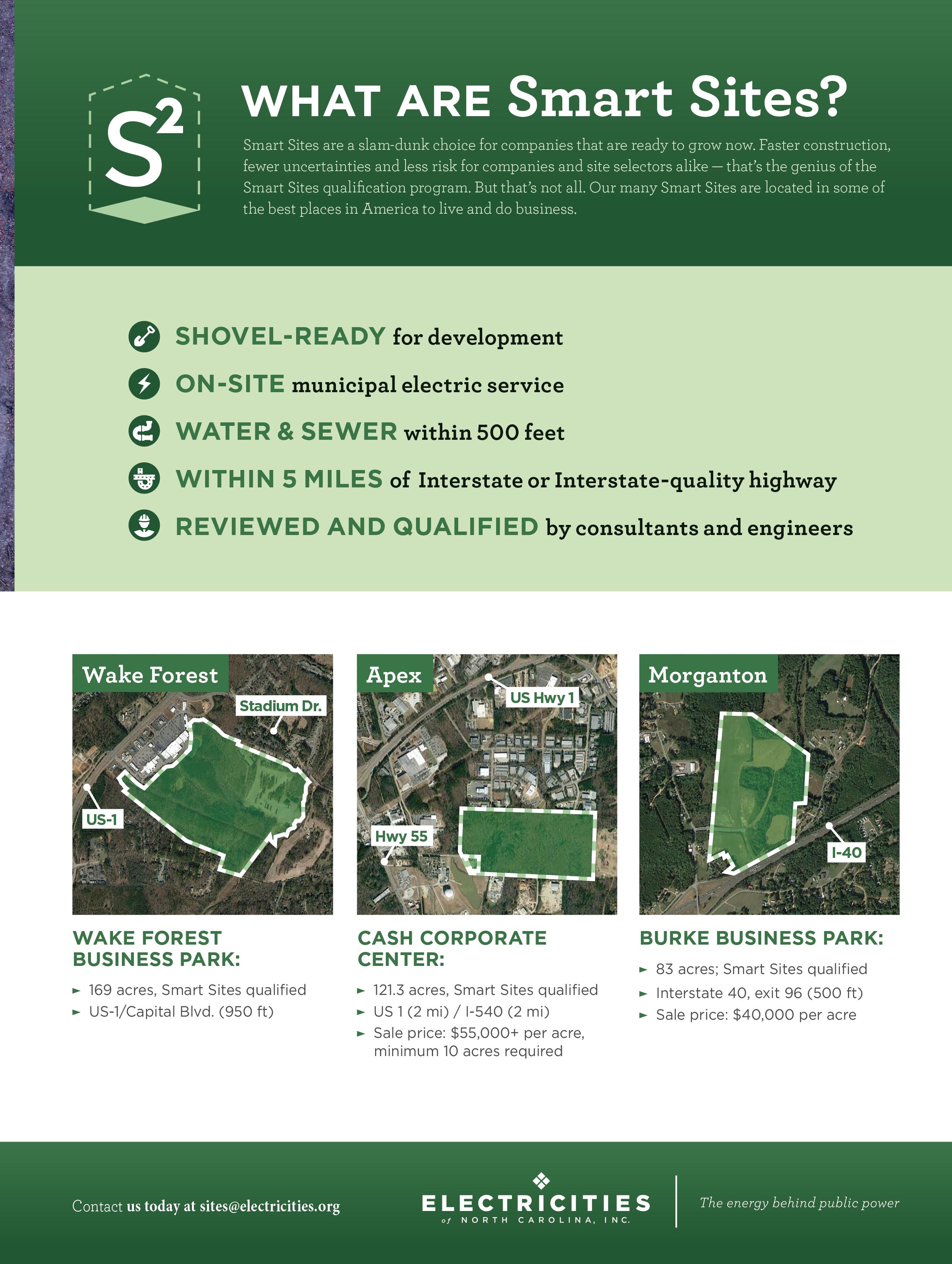

North Carolina’s 2.5% corporate income tax rate is the lowest among the 44 states that levy this tax. Starting in 2025, the rate will drop to 2.25% and decrease gradually until it ultimately is eliminated in 2030.
North Carolina was recently recognized as CNBC’s #1 Top State for Business in the annual ranking, which is an exhaustive study of business climate and economy, workforce, education, and lifestyle measures. is recognition is in addition to the state winning Area Development’s Platinum Shovel award, and both Site Selection magazine and Business Facilities magazine awarding North Carolina the #1 ranking for business climate in 2021 and 2022, respectively.
North Carolina has one of the fastest-growing populations in the country. Last year, the state grew at a rate nine times faster than the US average. is tremendous growth feeds directly into North Carolina’s robust talent pipeline. North Carolina residents have access to top-tier training from 52 college and universities. North Carolina’s 58-campus community college system is the third largest in the US. e North Carolina Community College System is also renowned for its highly personalized customized workforce training model. In 2021-22 alone, nearly 23,000 North Carolina workers received intensive job-speci c customized training through NCCCS in partnership with more than 770 new and existing companies.
North Carolina’s cost-e ective business environment is clear across several measures. e state’s construction costs are 17% below the national average, and industrial electricity rates are 14.5% lower than the national average. Overall, the cost of living in North Carolina is 11% lower than the national average cost of living. According to the 2021 Location Matters Report published annually by KPMG, North ranked #3 for lowest e ective tax rates for new rms and #5 for lowest e ective tax rates for mature rms.
North Carolina’s central East Coast location and superb road transportation network provide access to more than 180 million customers within a day’s drive. e state’s two deep water seaports and two Class 1 rail carriers enable companies to reach millions of domestic and international customers. North Carolina boasts several regional airports in addition to four international airports. Among these, Charlotte Douglas International Airport (CLT) is the world’s
h-busiest international airport as of 2022, and Raleigh-Durham International Airport (RDU) was ranked third in passenger satisfaction among large North American airports for 2022.
Fi y-two colleges and universities comprise North Carolina’s higher education system. Per the Carnegie Classi cations of Institutions of Higher Education, North Carolina is also home to three Tier 1 research universities: Duke University, UNC Chapel Hill, and North Carolina State University. e state also is home to several research parks, including North America’s largest — Research Triangle Park — which is home to more than 300 innovative companies employing more than 55,000 people.
7.
North Carolina’s low cost of living and family-friendly reputation make it an ideal place to call home. Residents enjoy a moderate climate yearround and unique access to a variety of stunning natural landscapes, anked by the Great Smoky Mountains and Blue Ridge Mountains to the west and 300 miles of pristine coastline to the east.
With more than 455,000 employees, North Carolina has the largest manufacturing workforce in the Southeast. is number continues to grow as the state has averaged a 6% increase in manufacturing jobs over the past 10 years. North Carolina also boasts the third-most jobs in the IT and analytical instruments sector in the Southeastern U.S. and ranks among the top 10 states in the nation for total employment this sector. Over 169,000 IT workers alone are employed in North Carolina.
North Carolina o ers eligible companies state and local programs that lower their costs and increase their global competitiveness, including performance-based grants tied to job creation. In recent years, legislators have signi cantly expanded possible grants for projects that create largescale employment and investment.
e Economic Development Partnership of North Carolina helps companies of all sizes identify sites, navigate economic development incentives, nd workforce solutions, and more. If you are interested in learning more about relocating or growing your business in North Carolina, please visit edpnc.com.


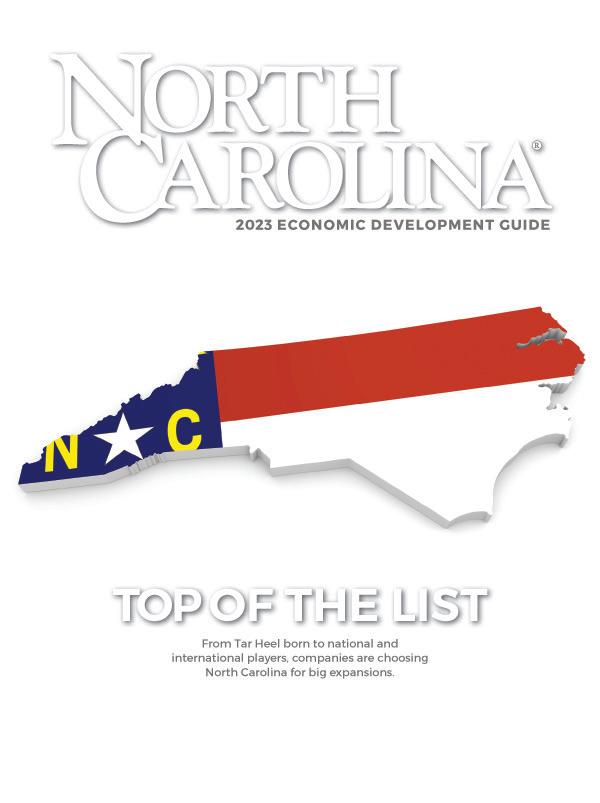


The Wright Brothers chose North Carolina for its sand dunes known as Kill Devil Hills. While their decision made history that’s still touted on state license plates, the state is attracting game-changers these days with much more than dunes.
Colorado-based Boom Supersonic picked Triad International Airport in Guilford County for the new manufacturing site of its Overture plane because of local aviation talent, key suppliers and the state’s strong support for its businesses. When the first Overture rolls out in 2025, it will fly at twice the speed of today’s jets and run on 100% sustainable aviation fuel.
Whether it’s aerospace, financial technology or another industry choosing North Carolina, companies are coming for a myriad of reasons.

Educational resources are at the top of the list with 52 colleges and universities, among which are three Tier 1 research universities, and 58 community colleges. North Carolina has the nation’s highest enrollment of students in Historically Black Colleges and Universities. When Apple chose Research Triangle for its 1-million-square-foot research, development and operations hub, the close proximity to three HBCUs was a factor in the decision. Businesses benefit from numerous partnerships with all schools and universities.
The military provides another talent pool. North Carolina has the
fourth-largest active-duty military population in the country with 18,000 well trained personnel entering the civilian workforce each year.
The state is known for its friendly residents as well as for being business friendly. The corporate income tax rate of 2.5% is the lowest in the United States. Recent tort reform and streamlined practices mean less red tape and litigation. When there is litigation, the North Carolina Business Court allows for faster access to trials and specific judges that focus on complex business issues.
It’s easy to get clients, employees and products to and from North Carolina. Charlotte-Douglas International Airport, the fifth-busiest airport in the world, offers access to virtually any major city across the globe. Ten airports across the state also enable efficient domestic and international travel.
Two Class 1 rail carriers and two deep-water seaports in Morehead City and Wilmington move products throughout North America.
Boom Supersonic is just one of several large employers who decided last year to invest multiple millions and even billions of dollars in N.C. facilities. The state also, of course, values and caters to smaller startups and entrepreneurs.
We’ve come a long way since that famous first flight in 1903. Entrepreneurs Wilbur and Orville would be proud.
— Katherine Snow Smith, project editorSince taking the helm as N.C. Secretary of Commerce in early 2021, Machelle Baker Sanders has helped steer the state’s economic development. Her department plays a key role in landing businesses that are making big investments and creating thousands of jobs. She’s also overseen new programs and tactics for supporting existing businesses, attracting new ones and increasing diversity.
Machelle Sanders came to the post with private and public experience. Most recently she was the Secretary of Administration leading the department that acts as the business manager for the state and oversees construction, purchasing and contracts.


Sanders also has 30 years of management and leadership experience in the pharmaceutical and biotechnology industries. She was vice president of manufacturing and general manager at Biogen’s largest manufacturing facility in Research Triangle Park and also held high-level posts at Purdue Pharma and Diosynth-Akzo Nobel.
Sanders earned a Bachelor of Science degree in Biochemistry from N.C. State University and a Master of Health Administration from Pfeiffer University.
She’s the mother of adult twin daughters and a native of Belhaven in Beaufort County, where she loves time on the Albemarle Sound and Pungo River.

I’m proud of the work towards transitioning North Carolina to a clean energy economy. We have established an office of Clean Energy Economic Development that focuses on transitioning North Carolina as a leader in the clean energy space. The N.C. Task Force for Offshore Wind Economic Resource Strategies was created. The work we are doing will bring potentially billions of dollars and (many) jobs to North Carolina in the clean energy sector. One of our universities, N.C. A&T State, was recognized and earned a grant for clean energy workforce. They received a grant for a new program called STEPs4GROWTH, which funds clean energy workforce training. I’m also proud of the launch of North Carolina’s strategic economic development plan, “First in Talent,” and its intentional incorporation of diversity, equity and inclusion throughout the plan.
We work with Chris Chung and the Economic Development Partnership of North Carolina as well as economic developers and workforce partners across the state with recruiting new businesses. We consult with local officials, state agencies and the General Assembly to ensure that we, as a state, align needs, strengthen, and expand key industries for long-term job creation, investment, and good corporate citizenship.
The other responsibility is Commerce’s role in negotiating deals in the best interest of our state with the support of the Governor and General Assembly. Our objective is always a positive economic impact for North Carolina while bringing family sustaining jobs across the state.
Rural North Carolina is a vital part of the state’s economy. It is a priority of the Department of Commerce to have a keen, sharp focus and to remain inclusive. The department of Commerce is involved in helping those communities become more sustainable. We’re talking about water and sewer infrastructure and broadband infrastructure. The governor has made it a priority to expand broadband access across North Carolina. That is vitally important and long overdue, frankly.
Through programs like those at Biogen, and the Lady Cardinals in state government, we are focused on female talent and increasing the presence of women in the STEM space or in public board rooms or leadership positions. It’s really to celebrate and highlight the unique skills and abilities that women bring to any setting, work environment or community. (The Lady Cardinals STEM Program for High School students) was designed to reach young girls and encourage them to pursue STEM fields. We have hosted (Lady Cardinal students) in Commerce. The STEM field has good paying jobs that lead to careers. The average salary five years ago was about $76,000.
We also know there is inequality of salaries between men and women not only in the STEM space, but across sectors. When we are able to encourage and sponsor young girls into these fields, it can help close that gap, we hope, by providing them equal opportunity to have a career in the STEM space. Greater female representation will accelerate innovation, improve businesses’ bottom line, and expedite solutions for the world’s greatest problems. Women are the bedrock of society.
We need policies and champions to address the salary inequities (in all industries) that are solely because of gender. There are females who are working in the same role as males with the same level of experience and qualifications yet are paid substantially less. The Council For Women Report found women in North Carolina earn a median income of about $36,000, an average of $8,600 less than men. That is not acceptable. We also know if the current trend continues, working women will see equal pay in 2060. Not only is (addressing the inequality) the right thing to do, it’s an economic issue and it’s a family issue. It’s not just a woman’s issue.

There is a lack of gender diversity on public boards. I am a member of OnBoardNC and our focus is to increase gender diversity on public boards. I would like to see companies in North Carolina reap the benefits of including women on their public boards. Not only will these women enjoy personal development and career growth but these companies will also get the best return on their investments and have the best bottom line for their business. Greater female representation will accelerate innovation, improve businesses’ bottom line, and expedite solutions for the world’s greatest problems.
Data shows public boards with gender and racial diversity as well as diversity of thought and perspective are the companies that have breakthrough products and services garnering competitive advantage.
In North Carolina, we value diversity and inclusive business practices. We want to help businesses evolve to transform themselves to inclusive practices. Progress has been made.

North Carolina is the best place to expand and to create a thriving business. We have premier universities and community colleges with strong private and public partners across the state.
We have an excellent quality of life. It’s an unparalleled quality of life. You can live, work and thrive here. This is a welcoming
state and community. Our environment fosters entrepreneurship and innovation.
We have a great business climate, recognized as the best in the nation. We can help businesses navigate and hit their operational timelines. We have shovel-ready sites. We are also a state that not only embraces diversity and inclusion. We live it in our communities.
When we were recognized by CNBC as the “No. 1” place to do business in the country, they talked about how we get things done. We collaborate across the aisle and across communities, across the state — rural and urban, beaches to mountains. We are a collaborative state and the way we get things done really matters and shows up in the success we’ve had.
We do not do this only when a company is assessing our state or starting to work with our state. We are lifelong partners. North Carolina can be counted on to lift your boat, to rise, and to shine with you.
The place I love to vacation most of all is at (my childhood) hometown of Belhaven. It’s a relaxing place. It’s a beautiful small, quaint town on the Pungo River and Albemarle Sound. There are one-of-a-kind shops on our Main Street and the best restaurant in the state, I believe. Spoon River. People are the warm charm of Belhaven. There’s nothing better than eastern North Carolina.

Charlotte and the Triangle are leading the way as North Carolina becomes a fintech hub.
By Lawrence BivinsThe post-pandemic transformation of the workplace has shu ed the deck for communities and companies hoping to draw — and keep — tech-savvy employees. e work-from-anywhere trend has led to an exodus from crowded, expensive metro areas like New York City and San Francisco for more a ordable and livable places.
North Carolina’s global leadership in banking, information technology and nancial services makes it a natural t for businesses and professionals in “ ntech.” is modern industry serves both businesses and consumers with applications that make nancial transactions and money management faster, more convenient, safer and more e cient. Globally, the ntech market is projected to reach $460 billion by 2025, according to a study by Adroit Market Research.
Charlotte, the nation’s second-largest nancial service center, continues to gather the lion’s share of the state’s ntech attention and job growth, though the Triangle and Wilmington are also poised for a sizable cut of the market.
e Queen City is enjoying an impressive run of announcements by major names. In mid 2022, e Bank of London unveiled plans to base its U.S. Global Platform & Services headquarters in Charlotte, a move that will spark a $33 million annual payroll impact for the region when sta ng is complete in 2026. e bank will employ 350 people at the intersection of Trade and Tryon streets in the center of the city. Sta will include so ware developers, engineers, technology professionals and risk management specialists.
“We’ve chosen Charlotte as a key location to drive our agenda forward, enabled by Charlotte’s unique combination of banking talent, technologists and nancial business




leaders,” according to Jim Ditmore, co-president and group operating officer at The Bank of London. The company’s clients range from banks and clearing houses to government agencies and global payment networks.
Launched in 2021, The Bank of London, also has offices in New York City, Belfast and London. “The Bank of London has truly game-changing and patented technology that will power the borderless economy of the future,” Ditmore says.
Developing Charlotte’s fintech cluster is a clear priority for local leaders.
“We continue to demonstrate that Charlotte is the epicenter of where finance and technology converge,” said Mayor Vi Lyles, upon joining The Bank of London officials in announcing the bank’s choice of Charlotte for its U.S. operations. “This announcement further builds on our strategic international partnerships, and I look forward to seeing The Bank of London’s growth in our city.”
County and municipal leaders have seized on fintech as a path to bringing additional diversification to Charlotte’s labor market, which had been stung by the loss of high-dollar banking jobs in the wake of the Great Recession 15 years ago.
“Charlotte is aware of how valuable the industry is and how it can sow prosperity for a really broad array of citizens,”

says Chris Kouri, an economic development attorney at the Charlotte office of Nexsen Pruet who advises businesses on site selection. When recruiting fintech companies, government entities can deploy the Business Investment Program, a local economic development incentive that triggers lucrative state benefits available under the Jobs Development and Investment Grant (JDIG) program. Charlotte’s capacity to meet JDIG’s local match requirement, for example, enabled the North Carolina Department of Commerce to offer performance-based awards totaling more than $13.2 million to LendingTree. The leading online marketplace for consumer financial services announced major expansions to its Charlotte headquarters in 2016 and 2018.
LendingTree was founded in Charlotte in the late 1990s, and its phenomenal success has prompted significant additions to both its office space and talent force.
“I’m thrilled that this city and the State of North Carolina will remain the indisputable location for our corporate headquarters as we expand our footprint and advance our leadership position within the Fintech industry,” said Doug Lebda, founder and CEO of LendingTree.
“LendingTree has experienced incredible growth in recent years, and after a thorough process, we are excited to continue
UNC Charlotte Gardner-Webb University
Queens University
Central Piedmont Community College
Rowan-Cabarrus Community College, multiple campuses Gaston College, multiple campuses
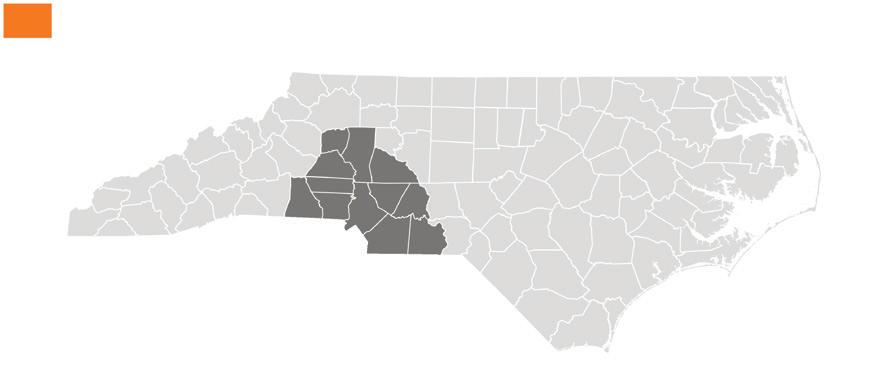

U.S. National Whitewater Center, Charlotte Harvey B. Gantt Center for AfricanAmerican Arts & Culture, Charlotte Charlotte Motor Speedway, Concord Carolina Panthers, NFL team, Charlotte NASCAR Hall of Fame, Charlotte Charlotte Hornets, NBA team


Charlotte FC, professional soccer club
Charlotte Knights, minor league baseball team

Carowinds, Charlotte Discovery Place, Charlotte

Daniel Stowe Botanical Gardens, Belmont Schiele Museum of Natural History and Planetarium, Gastonia

N.C. Transportation Museum, Spencer Lake Norman and Lake Wylie INDUSTRIES
Business, financial services and fintech Corporate headquarters Aerospace and defense Textiles
Energy
Automotive-parts
that growth in Charlotte.” The firm also maintains offices in California, New York City and Chicago.
“Charlotte leaders have seen over the last decade the quality of jobs created by fintech, the entrepreneurial nature of that industry, and how these companies support a vibrant start-up community here,” Kouri says. State support is critical, he adds, but given Mecklenburg County’s significant size and wealth, state programs require local partners to be on board. “There are also a lot of workforce programs city and county staff are knowledgeable about and can connect clients to.”
Programs include customized training from Central Piedmont Community College, employee screening and hiring support available through Charlotte Works, the local workforce development board, and strategic partnerships with institutions such as UNC Charlotte, one of North Carolina’s largest higher education campuses.

Retirement Clearinghouse similarly exemplifies Charlotte’s competitive edge in fintech. Founded there in 2001, the company uses innovative technologies to provide retirementplan management services to workers nationwide as they navigate among employers and retirement plans during their careers. In 2020, the company announced a $4.1 million
expansion that brought 300 new jobs to Charlotte. Through a network of partnerships with 401(k) recordkeepers, third-party administrators and pension plan sponsors, Retirement Clearinghouse has reduced employee cash-outs by 52%, thus enhancing retirement prospects for millions of American workers, according to the company.
A plus for area employees, the company’s new hires include individuals without college degrees or prior experience in finance or technology.
“The ability to tap into Charlotte’s hidden sources of fintech talent has been huge for them,” says Kouri, who advised Retirement Clearinghouse. “This is a company that can work with folks at all levels,” providing in-house training for those lacking the formal educational credentials and career backgrounds other tech companies seek.
The distinction resonated with local officials, creating synergies between the firm and the city. “Retirement Clearinghouse needed access to people to fill all their new positions just as Charlotte was working hard to connect an overlooked pool of job seekers with livable job opportunities,” Kouri says. “It was a win-win situation.”
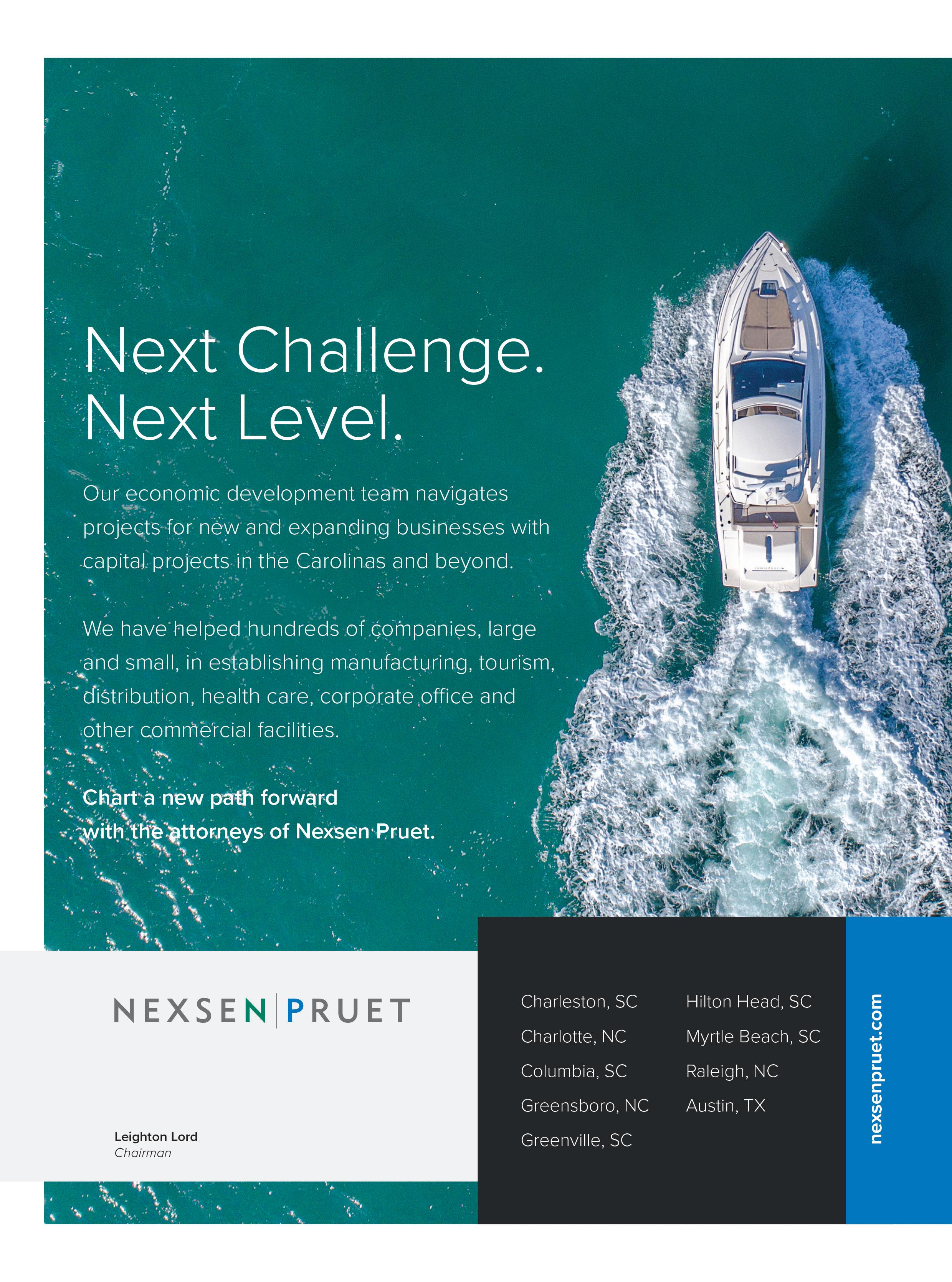
Steady flows of finance, business, computer science and engineering graduates from Duke University, UNC Chapel Hill, North Carolina Central University and North Carolina State University have helped fuel the success of companies like MetLife, Credit Suisse, Fidelity Investments, Deutsche Bank and others drawn to the Triangle in recent years as consumer tastes shift to digitally based financial products.
The pandemic accelerated that transition, which was among the reasons Fidelity Investments decided to significantly boost its RTP-based technology and customer contact staff in 2021.

Credit Suisse is another fintech operation that has relied heavily on local talent, especially Wake Technical Community College graduates, since arriving in the area in 2005. About half the Swiss company’s 2,000 Triangle employees work in technology operations.

In 2022, the company announced a $250,000 commitment through its Credit Suisse Americas Foundation (CSAF) to support the college’s WakeWorks® Apprenticeship program. WakeWorks® offers young people strategic pathways to career opportunities through skills development, access to employers, earned income and “stackable” credentials. The funds will help Wake Tech broaden apprenticeships across a wider network of local employers.
“At Wake Tech, we sometimes use the phrase ‘ladder economics’ to refer to our college’s approach to inclusive opportunity through education, training and career development,” says Wake Tech President Scott Ralls. “The support by Credit Suisse will make a difference by ensuring that apprenticeship opportunities are more readily accessible and more people in our communities have the opportunity to ladder into the outstanding job opportunities available today in our region.”
N.C. State University, Raleigh N.C. Central University, Durham UNC Chapel Hill Duke University, Durham Wake Technical Community College, multiple campuses



Central Carolina Community College Durham Technical Community College
North Carolina Museum of Natural Sciences, Raleigh
PNC Arena, home of NHL’s Carolina Hurricanes and N.C. State basketball, Raleigh State Farmers Market, Raleigh
North Carolina Courage, women’s professional soccer team, Cary
North Carolina Museum of Art, Raleigh Durham Performing Arts Center

Durham Bulls Minor League Baseball, Durham Morehead Planetarium and Science Center, Chapel Hill
Marbles Kids Museum, Raleigh
North Carolina Museum of History, Raleigh Museum of Life and Science, Durham Koka Booth Amphitheater, Cary
Biotechnology and pharmaceuticals

Information technology
Fintech
Clean technology
Higher education State government

Some homegrown North Carolina nancial pioneers are using technologies to reach underserved consumers across the state. at is the mission of Civic Federal Credit Union, which was chartered in 2019 as a digital- rst not-for-pro t nancial institution. It works to reach municipal governments and employees in the small towns that increasingly lack brick-andmortar commercial banks.
“We provide services to the people who keep our state running,” explains Lamar Heyward, chief marketing o cer at Civic FCU. “We wanted to start a credit union from the ground up with best-of-breed nancial services that are competitive with other institutions in the marketplace.”
Headquartered in north Raleigh, Civic FCU has no physical branches or ATMs. Still, a er only three years, it serves 3,800 members statewide and currently has assets totaling $100 million – both measures achieved solely through organic growth.
Its success has earned it recognition as one of America’s fastest-


growing credit unions by Callahan & Associates, a Washington, D.C.-based research rm that tracks credit union trends.
“We’re now turning up more of a focus on the consumer market with best-in-class products that can compete with the best banks and credit unions in the country,” according to Heyward.
Civic FCU utilizes its not-for-pro t mission to o er competitive yields on savings products, low rates on auto loans and rebated user fees on transactions conducted at ATMs of other nancial institutions. It o ers a 1 percent dividend yield on checking account balances, and it hopes to launch a mortgage product by 2024. Civic’s workforce totals 215, with more growth on the horizon.
“We’ve had a lot of success attracting and retaining talent because of our mission,” Heyward says. “We not only have access to great people with the right skills, but people with commitment and passion who are interested in working with an institution that can help build better lives and better futures for people who are serving our communities.”

Chris Ainsworth is among the many professionals finding a change of scenery in the Tar Heel State. In June 2022, the global human resource executive arrived in Wilmington to begin work as chief people officer at nCino Inc., a fast-growing provider of banking software founded and headquartered in the port city. Ainsworth, whose career has included positions at financial giants in New York and New Jersey, was eager to join a disruptive firm in a community hungry to build on its reputation as a fintech hub.
“As a recent transplant to North Carolina myself, I am privileged to join a company that is passionate about progressing the industry forward, helping to grow the region and making a meaningful impact within our local community,” says Ainsworth, who is one of 420 workers nCino has recruited to Wilmington from around the country since 2020. “It remains a top priority for nCino to attract top talent and, ultimately, contribute to the city and state’s growing status as a tech hub.”
The July 2020 initial public offering for nCino was a showcase for one of fintech’s hottest names. The company was started in Wilmington in 2011 with 15 employees. With a name derived from the Spanish word for “live oak,” nCino now has an 1,800-person global workforce housed at offices in Wilmington, Japan, Australia, Canada and the United Kingdom.
The company’s financial technologies are used by 1,200
financial institutions around the world. Its cloud-based nCino Bank Operating System helped financial institutions across the globe support businesses during the pandemic, so that lenders could respond quickly to the needs of customers during that uniquely challenging time.

The company’s high-profile IPO along with its growing success, has similarly put Wilmington on Wall Street’s radar screen.
“Greater Wilmington’s economic diversification took on a new dimension with the successful IPO by nCino in 2020,” says Scott Satterfield, chief executive officer at Wilmington Business Development (WBD), a nonprofit that oversees economic development for the city and surrounding New Hanover and Pender counties. “No longer is North Carolina’s fintech story only about Charlotte and Research Triangle Park.”
When combined with the success of Live Oak Bank, a homegrown digital-only bank that is the nation’s No. 1 SBA lender, nCino has underscored Wilmington’s powerful brand as a magnet for technical talent.
“All of this activity has put our region on the map as a center for fintech operations,” says Satterfield. He also credits Wilmington’s modern digital infrastructure, abundant Class A office space, user-friendly international airport, and attractive business and living costs as factors behind the success of nCino, Live Oak Bank and other companies.


Abountiful agriculture system has dominated the region’s economy and business dealings for decades. But more is stirring here than crops. Infrastructure improvements are underway, bringing new opportunities to longtime industries, such as health care, manufacturing and tourism. Newer sectors, such as biotechnology, have taken root and are growing across eastern North Carolina. Educational and workforce development opportunities are expanding, ensuring a skilled workforce is available.
Lawrence Bivins is a former managing director of policy and public a airs for the Raleigh-based North Carolina Economic Development Association. He’s bullish about eastern North Carolina. “If it were a publicly traded company, I’d be buying shares of stock right now,” he says. “Eastern North Carolina is in many respects a very rich place, not always nancially but in terms of history and culture. e infrastructure is coming in. e leadership is working on solutions. We’re working on keeping the talent that we have.”


e Greenville-based NCEast Alliance, which develops business and industry in eastern North Carolina counties, completed a strengths, weaknesses, opportunities and threats analysis in September 2020. It identi ed workforce and entrepreneurial development as ways to unite its 29 members. It said they need “to work speci cally with the talent that we have, the economic landscape that we nd ourselves in, while aiming toward the economic landscape that we hope to see in the future.”
Bivins says economic development’s priority is always the problem that’s most di cult to solve at the moment.
“And that’s people — workforce and talent,” he says. “You can invest in all the infrastructure, site prep, natural gas, broadband — but that’s really putting the cart before the horse. So how do you change this overnight? How can you change the hemorrhaging of young people leaving at [age] 18 and never looking back? You need
EasternNorth Carolina,
aperennial agricultural powerhouse,
is turning new leaves. It’s refocusing, expanding andcultivating
assets to create a bountiful future.
East Carolina University, Greenville UNC Wilmington UNC Pembroke
Fayetteville State University
Fayetteville Tech Community College
Cape Fear Community College, Wilmington Pitt Community College, Greenville




Cape Hatteras Lighthouse and Wright Brothers Memorial, Kitty Hawk
Historic Tryon Palace, New Bern
Battleship North Carolina, Wilmington Airlie Gardens, Wilmington

1886 Roanoke River Lighthouse, Edenton North Carolina Aquariums: Kure Beach, Roanoke Island, Nags Head and Pine Knoll Shores
Fort Fisher State Historic Site, Kure Beach N.C. Maritime Museums: Beaufort, Hatteras, Southport
to reach out not just to the 18-year-olds but the parents, too. You have to help the parents understand [benefits of] staying around and going to community college and getting an associate degree in culinary arts, in aircraft maintenance — there are careers that are in high demand. That’s a viable alternative to going away to a big fouryear university, so you can manage a hedge fund.”
Two programs — Rivers East Academy for Advanced Manufacturing and STEM workshops — expose high school students to hometown career options. “These projects are pursuing the opportunity to better educate teachers on what jobs exist in eastern North Carolina to steer local students to those jobs,” says Trey Goodson, NCEast regional economic developer and director of marketing and communications. “The plan is to expand these initiatives to [the Alliance’s] entire 29-county region.”
Rivers East Academy, funded by the Golden LEAF Foundation to advance the Regional Advanced Manufacturing Pipeline for Eastern North Carolina — RAMP East — launched in Beaufort, Bertie, Hertford, Hyde, Martin and Pitt counties in late 2021. It trains faculty from high schools and community colleges, along with community college student “ambassadors,” to use inspiration, motivation and empowerment to ease students’ transition from high school to community college to a career.
STEM East, in collaboration with businesses, economic developers and other entities, uses state-of-the-art instruction labs in Craven, Jones, Lenoir and Wayne counties, to educate students on career options and align them with opportunities. The College of the Albemarle, for example, has campuses in Elizabeth City, Barco, Manteo and Edenton, and its course offerings include manufacturing and transportation, hospitality and public service,
and health and wellness. “In the post-COVID world, we’ve really identified how important strengthening our workforce and infrastructure will be for the future of Chowan County,” says Liza Layton, Edenton Chowan Partnership executive director. “We are working with our local community college, school system and other partners to promote the school-to-work pipeline and enhance workforce training for our industry and business.”
ECU Health Medical Center in Greenville is the largest of the system’s 10 hospitals. More than 12,000 workers make it the region’s largest private employer, and it’s the teaching center for the Brody School of Medicine at East Carolina University. The university and the not-for-profit health company, formerly known as Vidant, entered a joint operating agreement in early 2022, creating ECU Health. The newly formed entity will train the next generation of physicians.

“The two mission-driven organizations will create enhanced rural health training opportunities for medical students and residents, as well as expanded research and clinical trial capabilities,” says spokesperson Brian Wudkwych. “[The two] will integrate under the new shared brand.”
Another key provider, New Bern-based CarolinaEast Health System welcomes UNC Health medical students, fellows and residents, one facet of an affiliation agreement announced last year. “The affiliation will enhance the quality of health care in the eastern region while simultaneously growing specialty services in Craven County and beyond,” says CarolinaEast President and CEO Ray Leggett. “This affiliation underscores both

organizations’ commitment to rural health care [and] expands the range of services CarolinaEast offers today, including those in the pediatric population.”

The affiliation also expands offerings at 80,000-square-foot SECU Comprehensive Cancer Center at CarolinaEast Medical Center.
“As a result of that partnership, patients receive cancer treatment capabilities not previously available in the East,” Leggett says. “Residents of Craven County no longer need to travel to the Triangle for leading-edge clinical trials, treatment protocols and the skill of additional oncology specialists to aid their care.”
CarolinaEast provided a $150,000 grant to Craven Community College. It supports a full-time nursing instructor that allows for increasing class size and producing more graduates to help meet the growing need for nurses, says Jim Davis, the health system’s chief nursing officer. CarolinaEast organizes a health care career day for high school students from Craven, Jones, Pamlico and Carteret counties.
“We educate students about health care careers by having different disciplines in the classroom,” says Lesley Hunter, the system’s vice president of human resources. “We are a site for
[career technical education] students, and they are routinely in the medical center. We also present tips for interviewing and resume writing. We also provide scholarship opportunities to students graduating from high school to provide financial assistance to attend healthcare programs in the local community college and universities.”
Todd Edwards is a founding member of The Farmville Group, which helps bring businesses to Farmville, 10 miles west of Greenville on N.C. 264. He also serves on NCEast’s board. Edwards calls interstates “ribbons of prosperity for the regions they serve.”
Several interstate projects are dawning a new day across the region, whose options have been limited to interstates 40 and 95 for decades.
“It has been an unpleasant outward sign of our overall lack of prosperity, compared to the rest [of the state],” Edwards says. “Up until now, most of eastern North Carolina has not been on that playing field. We are soon to have new fields all over our region
to play on, and that future is looking very bright because of prospects that these highways bring.”
Edwards says 137-mile Interstate 42, which will use a long stretch of U.S. 70, is under development. It will connect Raleigh, I-95 and I-40 and improve access to the Port of Morehead City, U.S. Navy’s Fleet Readiness Center East in Havelock, Marine Corps Cherry Point Air Station and the Crystal Coast, a popular tourist destination on the southern Outer Banks. It also will link to 2,500-acre Global TransPark in Kinston, a multimodal industrial park and airport that supports defense, aerospace, manufacturing and advanced materials companies. Its onsite workforce training center — Spirit Aerosystems Composite Center of Excellence — is a partnership with Lenoir Community College.
Another “ribbon,” future Interstate 587, an upgraded stretch of U.S. 264, is near completion. “[It] will connect ECU Health, [East Carolina University] and a large cluster of pharmaceutical and boat industry manufacturers to the rest of the world,” Edwards says. “Finally, the partially completed I-87 from Raleigh to Norfolk has recently garnered newfound attention and is being heavily considered for some fast tracking to renewed planning and funding initiatives in the very near future. This will be a huge boost for all of eastern North Carolina, Raleigh and our friends in the Tidewater region. It is a project being pushed from both sides of the VirginiaNorth Carolina line.”

Interstates support the region’s BioPharma Crescent, which arcs across Edgcombe, Johnston, Nash, Pitt and Wilson counties. More than 10,000 people work there. It’s home to some of the industry’s biggest companies, including GlaxoSmithKline, Pfizer and Thermo Fisher Scientific. “Logistically, they’re near [Research Triangle Park] and in an area with plenty of available land and plenty of industrial sites where there
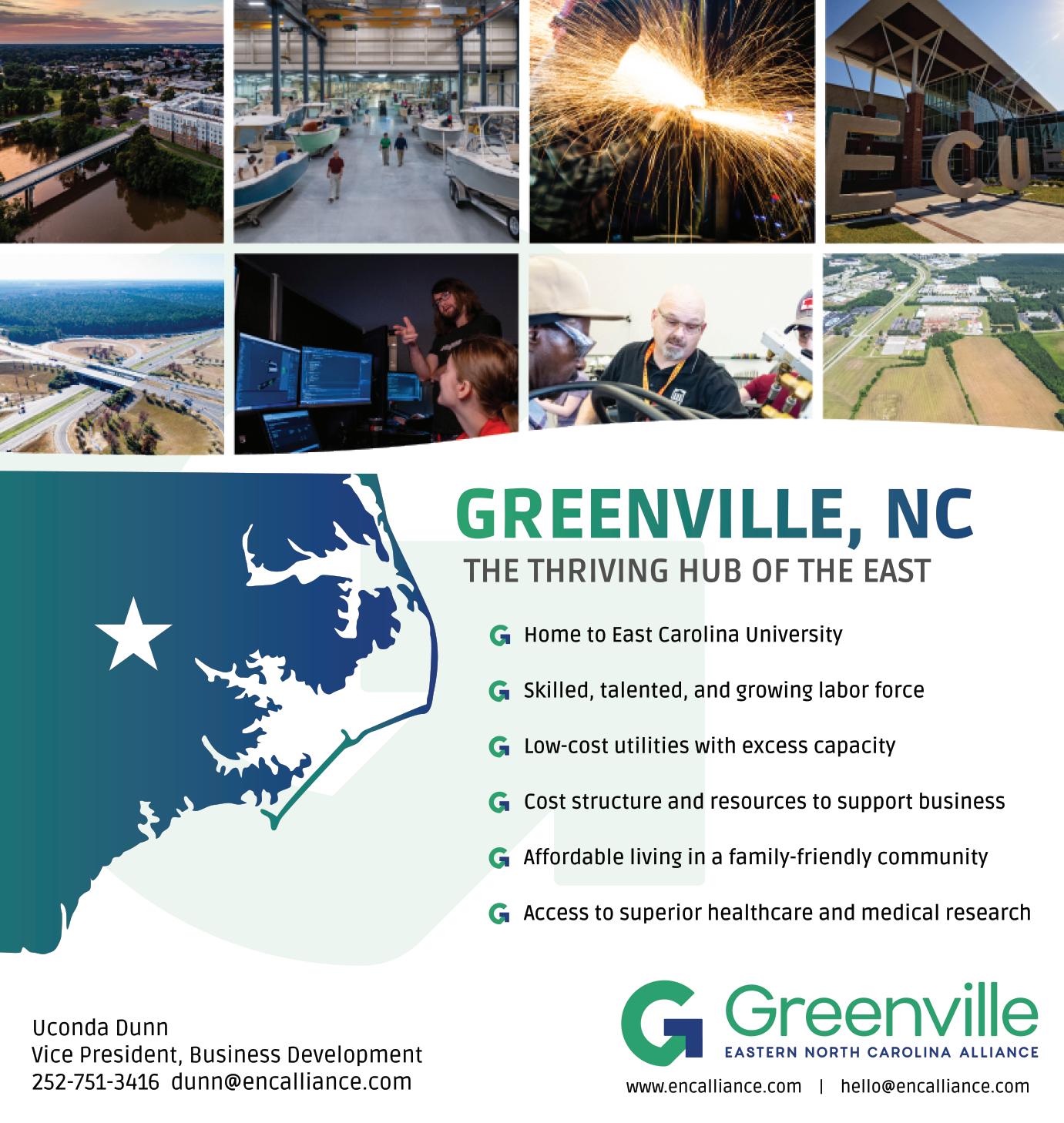
is an affordable cost of living,” Bivins says. “Plus, they’re near I-95 and the port [of Morehead City].”
Kitty Hawk Offshore is a proposed 122,405-acre wind-power project about 28 miles off Currituck County’s coast. It would generate enough electricity to power 700,000 homes. Avangrid Renewables has been studying it since 2017, when it was awarded a lease by the U.S. Bureau of Ocean Energy Management. The Portland, Oregon-based energy developer submitted its construction and operations plan in December 2020.
Construction and operation will begin after it is approved and energy buyers secured.
Former Currituck County Economic Development Director Larry Lombardi says offshore wind projects are tremendous economic opportunities that create high-paying jobs. Dominion Energy is building one off the coast of Virginia, which has welcomed such projects with open arms.
“Currituck County’s role will be to provide a greenfield of new buildings for the second- and third-tier manufacturers and suppliers to these projects,” he says. “Due to the rising cost of land, the tax structure and as more manufacturing sites in Virginia’s Tidewater become hard to find, Currituck County being right over
the state line with its lower taxes and proximity to the Outer Banks will be able to leverage those advantages and capture some of those companies looking to supply the [wind-energy] projects.”
Lombardi describes Currituck County’s recent growth as “tremendous.” Its school district plans to add a $30 million elementary school, for example, within three to seven years. And Currituck County Regional Airport in Maple is poised for its first updates in more than two decades. They include a longer runway, more hangars and modern runway lights. Government grants will pay for 90% of the cost. “Now that we have the [airport] layout plan, we can move forward in trying to find the [local] funding, hopefully from the state by lobbying our elected state representatives,” he says.
Edenton Chowan Partnership’s Layton wants to see more.
“I’d be remiss if I didn’t mention broadband,” she says. “What a need we’ve seen through the pandemic and after. We have to figure out how to expand quality and reliable broadband in our state so children in rural areas have the same opportunities as those in the urban centers. Chowan County has made the expansion of broadband a priority and is committed to being a partner to internet-service providers in the area.”



e Port of Wilmington, where nished goods, such as furniture and fertilizer, arrive and agricultural products and auto parts depart, is 26 miles up the Cape Fear River from open ocean.
“We have the capability to have the largest boats that use the Panama Canal call on the Port of Wilmington,” says Christina Hallingse, N.C. State Ports Authority communications manager. “We have trans-Atlantic services, ships that are either northbound or southbound to and from Central America, or trans-Paci c, a number of places.”
But the Port could do more. Its 42-foot-deep channel, 6,768 feet of wharf frontage and 100-acre container terminal can handle 600,000 shipping containers worth of goods annually. But it can’t welcome larger fully loaded ships. ose require a channel that’s at least 47-feet deep at low tide.
“A more e cient channel would modernize the Port, attract more import and export business, help mitigate East Coast congestion, and help North Carolina ports become an even stronger player in this competitive landscape, thereby supporting the economy of Wilmington, New Hanover County, eastern North Carolina and the entire state,” Hallingse says.

Help is on the way. Congress approved the Wilmington Harbor Navigation Improvement Project in late 2020. It includes dredging the Cape Fear River, which is estimated to cost $834 million, according to a feasibility study commissioned by the ports authority. e dredging project is one of several
underway on the East Coast. e Army Corps of Engineers is deepening the port in Savannah, Georgia, and the channel in Charleston, South Carolina. Norfolk, Virginia, has begun a project to make its port 55-feet deep by 2024, which will make it the East Coast’s deepest.
North Carolina’s other port in Morehead City is four miles inland. Ships, which set sail with wood chips, aircra parts and other cargo, access it through a 45-foot-deep channel. It has more than 1 million square feet of warehouse space and, like Port of Wilmington, is served by rail.
“Ports are catalysts for economic development,” Hallingse says. “ e N.C. State Ports Authority works in conjunction with the Economic Development Partnership of North Carolina on any potential projects that they are recruiting that could utilize or bene t from the proximity and access to a port.”
Eastern North Carolina is home to many industries, such as agriculture and food processing. ere’s boat building, too, including well-known Grady-White in Greenville. e Perquimans Marine Industrial Park recently received state funding. “ e $4 million will be used to construct a basin at the industrial park,” says NCEast’s Goodson. “ is will help recruit boat builders who have shown interest in the park in recent years.”
ElecriCities of North Carolina, which represents municipal electric utilities in the Carolinas and Virginia, certi ed the 71-acre Perquimans Marine Industrial Park as a Smart Site. It’s shovel ready for development with on-site municipal electric service, water and sewer services within 200 feet, and less than ve miles from an interstate or interstate-quality highway.
Visitor spending in North Carolina totaled $28.9 billion in 2021, according to Visit NC, EDPNC’s tourism promotion arm.
As the pandemic eases, the state’s tourism industry is rebounding. at’s especially true in eastern North Carolina, whose accommodations, beaches and golf courses have been attractions for generations. e North Carolina Economic Development Association, for example, held its recent spring conference in Pinehurst. “We have 25 site-selection people ying in from all over the country,” Bivins said prior to the event. “We want to show that North Carolina is ready and reliable.”

Moore County had the state’s 10th-biggest tourism economy in 2021, taking in $673 million in the sector. It hosted the U.S. Women’s Open at Pine Needles Lodge & Golf Club in June 2021. e United States Golf Association’s second headquarters — Golf House Pinehurst — and a 34-room boutique hotel is under development.
“Overall, the USGA coming here will have a huge impact on tourism, especially with the new testing center and museum,” says Phil Werz, president and CEO of the Convention and Visitors Bureau for the Pinehurst, Southern Pines, Aberdeen Area. “ e [turf grass management component] will also have an impact based on the partnerships they are creating with local and regional universities, including Sandhills Community College, N.C. State University and North Carolina A&T.”

e Home of American Golf isn’t resting on its laurels. e CVB has launched “Paradise in the Pines,” a twice-monthly podcast that shares stories of local attractions, events and
residents. It also created a Sandhills Pour Tour Passport. Holders who have it stamped at seven local cra breweries qualify for a reward. “ ey receive a Sandhills Pour Tour mug and, while supplies last, a special Donald Ross 150th anniversary commemorative coin,” Werz says. “For every coin we give as a prize for a fully stamped passport, the CVB will donate $25 to support the Tu s Archives [history collection and display at Given Memorial Library] in the village of Pinehurst.” He says the passport encourages people to explore the whole county, beyond the greens, and support a variety of local businesses in the process.
Moore County is just one example of a longtime popular tourism destination in the East that continues to work to draw visitors. e beaches and other towns with their signature attractions are also constantly planting new seeds to grow their harvest as well.
The Triad and Carolina Core score big wins and prepare for more. Within less than 12 months, the region landed four big employers that are investing more than $13 billion in new facilities.
By Katherine Snow Smith and Kathy BlakeKeeping up with the economic development activity in North Carolina’s Triad region can lead to whiplash with all the head-turning from one big announcement to the next.
Toyota Motor in late 2021 announced that it’s building a $1.3 billion electric-battery factory at the Greensboro-Randolph Megasite and creating 1,750 jobs. It followed up in August with a $2.5 billion expansion and another 350 jobs when construction is completed.
A few months later, Boom Supersonic decided on Guilford County for the assembly of the world’s fastest airplane at Piedmont Triad International Airport. e Colorado-based company plans a $500 million manufacturing facility that will construct its Overture airplanes. It has pledged it will hire 1,750 employees by 2030 and create a workforce of more than 2,400 employees by 2032.
en in March, Vietnamese carmaker VinFast announced plans to invest $4 billion in a manufacturing operation at Chatham County’s Triangle Innovation Point. e company expects to hire 7,500 employees over the next ve years.
In September, Durham-based chip maker Wolfspeed picked the Chatham-Siler City Advanced Manufacturing Site for a $5 billion silicon carbide semiconductor plant. It expects to create at least 1,800 jobs paying an average of $77,753 a year.
ese companies’ decisions to plant some serious Triad roots have drawn national and international attention. e Toyota, Boom, and Wolfspeed plants are within 30 miles of downtown Greensboro, while VinFast’s site in eastern Chatham County is closer to Raleigh and Durham.
“I think we are de nitely on the map now if you’re moving your company,” says Mike Fox, president of the Piedmont Triad Partnership. Businesses throughout the South and up and down the East Coast have known the region’s advantages for decades. Now there’s even more awareness.
Fox cites the area’s draws: “ e workforce, the available land, the ease of living, the cost of living compared to a lot of other places, the low tax structure, the workforce development programs, the excellent universities and other schools.”
Piedmont Triad International Airport and the vast open acreage around are also big lures, especially to commercial aerospace companies.
“With some of the country’s best and brightest aviation talent, key suppliers, and the state of North Carolina’s continued support, Boom is con dent that Greensboro will emerge as the world’s supersonic manufacturing hub,” Blake Scholl, founder and CEO of Boom Supersonic, said in a release about his company’s decision.

UNC Greensboro
Wake Forest University, Winston-Salem
Elon University
High Point University
N.C. A&T State University, Greensboro Winston-Salem State University


Guilford Technical Community College
Forsyth Technical Community College

North Carolina Zoo, Asheboro
International Civil Rights Center & Museum, Greensboro
Old Salem Museum & Gardens, Winston-Salem

Greensboro Science Center, Greensboro
Andy Griffith Museum, Mount Airy
Yadkin Valley Wine Country, Elkin
Kaleideum (North and Downtown museums) Winston-Salem
Toyota leadership echoes his sentiments.
“ e future of mobility is electri cation and the GreensboroRandolph Megasite is the ideal location to make that future a reality,” Ted Ogawa, CEO of Toyota Motor North America, said in a release. “North Carolina o ers the right conditions for this investment, including the infrastructure, high-quality education system, access to a diverse and skilled workforce, and a welcoming environment for doing business.”
Toyota shared its relocation “wish list” that made the 1,800acre Greensboro-Randolph Megasite rise above other nalists.

■ An extensive and well-maintained highway system for overland logistics
■ Four international airports and two seaports
■ Onsite rail
■ An outstanding, diverse workforce
■ Renewable energy availability
■ World-renowned education system
■ Strong government partnership at both the state and local levels
State, county and local incentives also make a di erence. ese four companies alone will receive more than $2.5 billion from government entities for infrastructure and job creation.
e Triad’s counties are Surry, Stokes, Rockingham and Caswell along the Virginia line, and Forsyth and Guilford at the center, surrounded by Yadkin, Davie, Davidson, Randolph, Montgomery and Alamance. Four years ago, the Piedmont Triad Partnership dubbed the area the foundation of the Carolina Core, where low tax rates, 2 million workers and 7,200 acres of certi ed land are attracting businesses, small and large.
readed together by a 120-mile stretch of U.S. 421 from Dunn to Yadkinville, the Carolina Core adds ve counties — Chatham, Cumberland, Harnett, Lee and Moore. When the Carolina Core initiative was announced in August 2018, the Partnership said one of the measures of success would be to create 50,000 jobs in the region over the next 20 years.
Since then, more than 37,900 new jobs have been announced. “We’re tracking ahead of schedule, absolutely,” Partnership spokesperson Melanie Jennings says.
Fox acknowledges with a laugh that they probably need to adjust the jobs forecast.
“ ere’s a delicate balance between meeting your goal and moving the goal line,” he says. “When we said 50,000 was the goal it was a very di erent landscape. ese megasites were not totally in play yet. It’s really just in the past 12 months that we’ve picked up such great momentum. We were getting singles and doubles but these home runs are accelerating things.”

e Carolina Core’s four certi ed megasites totaling 7,100 acres give plenty of room for playing ball.
e 1,800-acre Greensboro-Randolph Megasite that’s welcoming Toyota is minutes from I-40 and I-85. e ChathamSiler City Advanced Manufacturing Megasite has 1,800 acres of certi ed, shovel-ready land powered by excellent logistic and high capacity utilities. e 2,500-acre Moncure Megasite in Chatham County is close to Raleigh, the state capital, and Research Triangle. It’s within 45 miles of three Tier 1 research universities: UNC Chapel Hill, N.C. State University in Raleigh and Duke University in Durham.
And the Piedmont Triad International Airport 1,000-acre megasite that will be home to Boom Supersonic o ers tenants runway access among other in-demand amenities.
It’s not just just the “big dogs” that are attracted to the Triad and Carolina Core. e region has lures and supports for small businesses and entrepreneurs, too. Fox and his economic development partners across the region say it thrives with all sizes of employers. “We’re still chasing and winning those singles and doubles, too,” he says.
Nature’s Value, which is relocating from New York, will create 183 jobs and invest $19 million in a new headquarters and vitamin factory in Winston-Salem’s Whitaker Park.
Charlotte-based Nucor, the largest U.S. steel producer, is opening a $350 million plant in Lexington in Davidson County that will employ 180 people. Children’s clothing manufacturer LT Apparel Group is investing $57 million at Greensboro’s Reedy Fork Corporate Park and will create 116 jobs.
Commercial equipment provider Altec is expanding near Mount Airy, investing $9 million and creating 100 jobs. And ooring manufacturer Mohawk Industries is spending $87 million in an expansion that will create 87 jobs in Davidson County over the next three years.
Technimark, a manufacturer of injection-molded components, is investing $62 million in a Randolph County facility where it plans to employ 220.
“NorthPoint (Developers), one of the largest industrial developers and landlords in the country, manages over 105 million square feet of property. It’s developing a park in Kernersville,” Fox adds. e number of tenants and their employees are not yet known, but this is another big source of new jobs.


New, relocating and expanding small businesses all make a big impact.
“For every Toyota there are a thousand mom-and-pop small businesses out there, all working together to make the economy work,” Fox points out.
Congdon Yards in High Point is one of many facilities throughout the Triad catering to small businesses and entrepreneurs. ree historic buildings including a former hosiery factory now provide space for retail, restaurants, small business and start-ups. Construction of a Spring Suites by Marriott is also underway.
e Innovation Quarter in Winston-Salem has 2.1-million square feet of o ce laboratory and educational space. It’s home to 90 companies, 1,000 residents, ve academic institutions (including Wake Forest University), myriad community-based art projects and green walkways dotted with restaurants, cafes and galleries.

Whitaker Park is another innovative commercial space on 220 acres in Winston-Salem, for businesses of varying sizes. e manufacturing complex was donated by Reynolds America to Winston-Salem and Forsyth County. It served as R.J. Reynolds Tobacco’s main cigarette manufacturing facility and at one time was the largest plant in the world. Redevelopment of the site will generate thousands of jobs. e complex is located two miles north of downtown Winston-Salem and directly adjacent to Wake Forest University. As noted above, Nature’s Value is opening its facility there. Robert Leak, president and chief executive o cer of Whitaker Park Development Authority, o ers these other updates.
■ Second Harvest Food Bank is building their new headquarters and bulk distribution center on the site.
■ Brennan Investments purchased an 84,000-squarefoot building and is in the process of remodeling. There is strong interest from companies wanting to lease space.


■ JC Harris purchased a 2.7-acre site and is working on plans for a 25,000-square-foot spec building.


■ A 160-unit apartment project will be completed by mid 2023. The developer has optioned adjacent sites and is considering a mid-rise hotel or additional apartments.
■ Forsyth County owns two small warehouses and leases them to the school system.

■ A lab building is home to Virtue Labs and Nanosoft Polymers.
Whitaker Park has a Norfolk Southern rail spur onsite and is less than 30 minutes from Piedmont Triad International Airport and FedEx’s regional hub. e park has quick access to major interstates, including I-40, I-85, and future I-74. And it’s not just Whitaker Park that’s well connected. e Triad’s easy access to top notch transportation for all of its residents and worksites is a major draw.
e N.C. Department of Transportation is preparing a study and application for federal review, and two new interstate-quality interchanges will provide access to Toyota’s site from U.S. 421.
e $1 trillion infrastructure bill, which President Biden signed in November 2021, brings hopes of accelerating U.S. 421’s journey toward becoming Interstate 685, though money has yet to be designated.
“Connecting two of North Carolina’s most active interstate corridors — I-85 and I-95 — will mean that Future 685 can o er alternative and redundant access for goods and people moving through the center of our state in the event of storms and weather disruptions,” says Piedmont Triad Partnership’s Fox. “O entimes, companies looking to locate a new project want to be close to an interstate highway and may rule out a site that is not within a certain distance of the interstate. Designating the U.S. 421 corridor not only makes the Chatham County megasites more desirable in many consultants’ eyes but also brings interstate access to industrial sites in Lee, Harnett and Randolph counties.”




Interstate 685 would move more than goods. It would connect people to jobs, too. “It’s kind of obvious that if we have an interstate-level road that runs east and west, it does nothing but help us to access employees who would want to work at the airport,” says Kevin Baker, executive director of Piedmont Triad Airport. “Highway 421 is good, but it has its downfalls, like the occasional tra c signal, and having a full interstate would certainly be bene cial. ere are a lot of growing communities [southeast of PTI], and especially given the news of the Greensboro-Randolph site, a whole lot of people are going to need a place to live. ey are going to need housing, and they will need a place to y.”
e interstate designation has a military component, too. U.S. 421 runs a few miles from Fort Bragg, the U.S. Army’s largest installation by population and home to the famed 82nd Airborne Division and Special Operations Command.
“It would be a huge advantage from a military readiness perspective as well as continuity of services and so forth,” says Kevin Lacy, a N.C. Department of Transportation tra c engineer.
e Triad’s educational and workforce development opportunities are vast and varying. e area is home to 21 colleges and universities, which enroll more than 100,000 students, according to the Piedmont Triad Regional Council. e region’s community colleges regularly customize training to individual needs of businesses. ey support many industries, including advanced manufacturing, aviation and aerospace, automotive, biomedical and life sciences, technology, entrepreneurship, and logistics.
“We are particularly excited and proud to not only expand Wolfspeed’s footprint in our home state of North Carolina, but also our relationship with North Carolina Agricultural and Technical State University to develop a workforce of the future,” says Gregg Lowe, President and CEO of Wolfspeed, when he announced the company’s $5 billion facility. Wolfspeed is also partnering with the N.C. Community College System for other customized training programs.


Another educational asset, Jamestown-based Guilford Technical Community College, o ers more than 70 workforce training programs, including several in medical elds. It has three in aviation manufacturing, including a structures assembly program.

A portion of community college students are hired by the more than 200 aviation and aerospace companies that have landed in the region, particularly at PTI airport and in Greensboro, High Point and Winston-Salem. “Aviation and aerospace are key growth sectors for our region,” Fox says. e Piedmont Triad leads the state in the number of students enrolled in local community college aviation programs, with more than 500 students enrolled in Guilford Technical Community College programs alone. e college’s Aviation Campus in Greensboro is one of the Southeast’s best equipped maintenance training facilities.
Forsyth Technical Community College’s $16-million Mazie S. Woodru Aviation Technology Lab, which opened at Smith Reynolds Airport in Winston-Salem in late 2021, will train students to meet the high demand for aircra maintenance and avionics technicians. e facility honors Mazie Spencer Woodru , the rst African American elected as a Forsyth County commissioner and a champion of education and social justice.
It has a 15,356-square-foot hangar that can house up to eight aircra . Students learn to work with sheet metal and composites, electronics, paint, and piston and turbine engines in its classrooms and labs. “Talent in the Carolina Core has a strong work ethic,” says Michimasa Fujino, recently retired president and CEO of Honda Aircra Co., which established its Greensboro headquarters in 2006 and employs 1,500 in research and
development, manufacturing and customer service.

The region’s focus on aviation technology and manufacturing clearly was a lure for Boom and its plan to build a workforce to construct its Overture plane. The aircraft, which was featured on “60 Minutes,” will carry up to 88 passengers at twice the speed of today’s fastest passenger jet and be powered by fuel made from sustainable and renewable sources.
In August, American Airlines announced the company is buying up to 20 Overture aircraft, with an option for an additional 40.

The Boom Supersonic facility will sit on 65 acres, leaving 1,000 acres at PTI airport available for other employers.
“One of the main messages we want to make sure everyone understands is we’ve had all this success (landing big employers) and it’s validating. We’ve been at it for a long time,” says Fox. “But we are still open for more business.”
Western North Carolina is known for its majestic mountains and wildlife, breweries and wineries, small shops and the biggest house in the country. e region has been popular with tourists for well over a century, and in recent years, it also beckons a steady stream of businesses.

Asheville-based Biltmore Farms, founded in 1897 by George Vanderbilt, is just one example of how the West combines beauty and business. It has an expansive portfolio of housing communities, business, hotels and retail and mixed-use properties.
“ ere are a lot of special places in the country that are urban, and there are a lot of mountain areas, but having urbanity in the mountains is really unique,” says Ben Teague, vice president of strategic development for Biltmore Farms. “It balances the sophistication of the cities and the serenity of nature. ere’s a lot to be said for having nature and innovation together, and that’s what I think western North Carolina is.”
Tourism is the region’s biggest cash crop. Buncombe County, home to Asheville and the Biltmore Estate, took in $2.6 billion in tourist spending in 2021, according to the latest data from Visit North Carolina, the state’s tourism development arm. Buncombe had the second-highest economic impact from tourists a er Mecklenburg County.
When much of the travel and tourism industry struggled
during the worst of the COVID-19 pandemic, tourism industry experts say Western North Carolina’s abundance of open spaces allowed for socially distanced recreation that continued to draw guests.
Now, restaurants and stores are again packed. Hundreds of small businesses that feed, clothe and entertain tourists beneath “Shop Local” banners give North Carolina’s mountain towns distinct personalities. From Asheville (population 98,000) to Maggie Valley (population 1,100), and Boone (population 19,000) to Bryson City (population 1,400), microbreweries, artists, retailers and recreation businesses attract visitors who have been supporting the economy for multiple generations as well as newcomers.
Like any community that thrives on tourism, there’s a need to balance access for full-time residents. No downtown or mountaintop wants to fall into Yogi Berra’s old adage: “Nobody goes there anymore. It’s too crowded.”
“As a resident I have a tendency to go to outlying restaurants rather than right downtown during tourist season. I had a meeting downtown the other day and was able to get right in to eat without a problem,” says Kit Cramer, president and chief executive o cer of the Asheville Area Chamber of Commerce. “We’ve partnered with Go Local Asheville (business alliance) on “Go Local” cards. ey provide discounts to locals who buy them.”
Western Carolina University, Cullowhee
UNC Asheville
Appalachian State University, Boone Asheville-Buncombe Technical Community College




Biltmore Estate, Asheville
Blue Ridge Parkway
Carl Sandburg Home, Flat Rock

Nantahala Outdoor Center, Bryson City
Tryon International Equestrian Center, Mill Spring
Sliding Rock, Transylvania County
North Carolina Arboretum, Asheville
Grandfather Mountain, Linville
Chimney Rock State Park, Chimney Rock
Linville Caverns, Marion
Asheville Tourists minor league baseball
Hickory Crawdads minor league baseball
Cherokee Cultural Attractions, Cherokee
Tweetsie Railroad, Blowing Rock

While tourism is a major economic driver, North Carolina’s western counties are home to a variety of larger employers in sectors such as health care, manufacturing and construction.
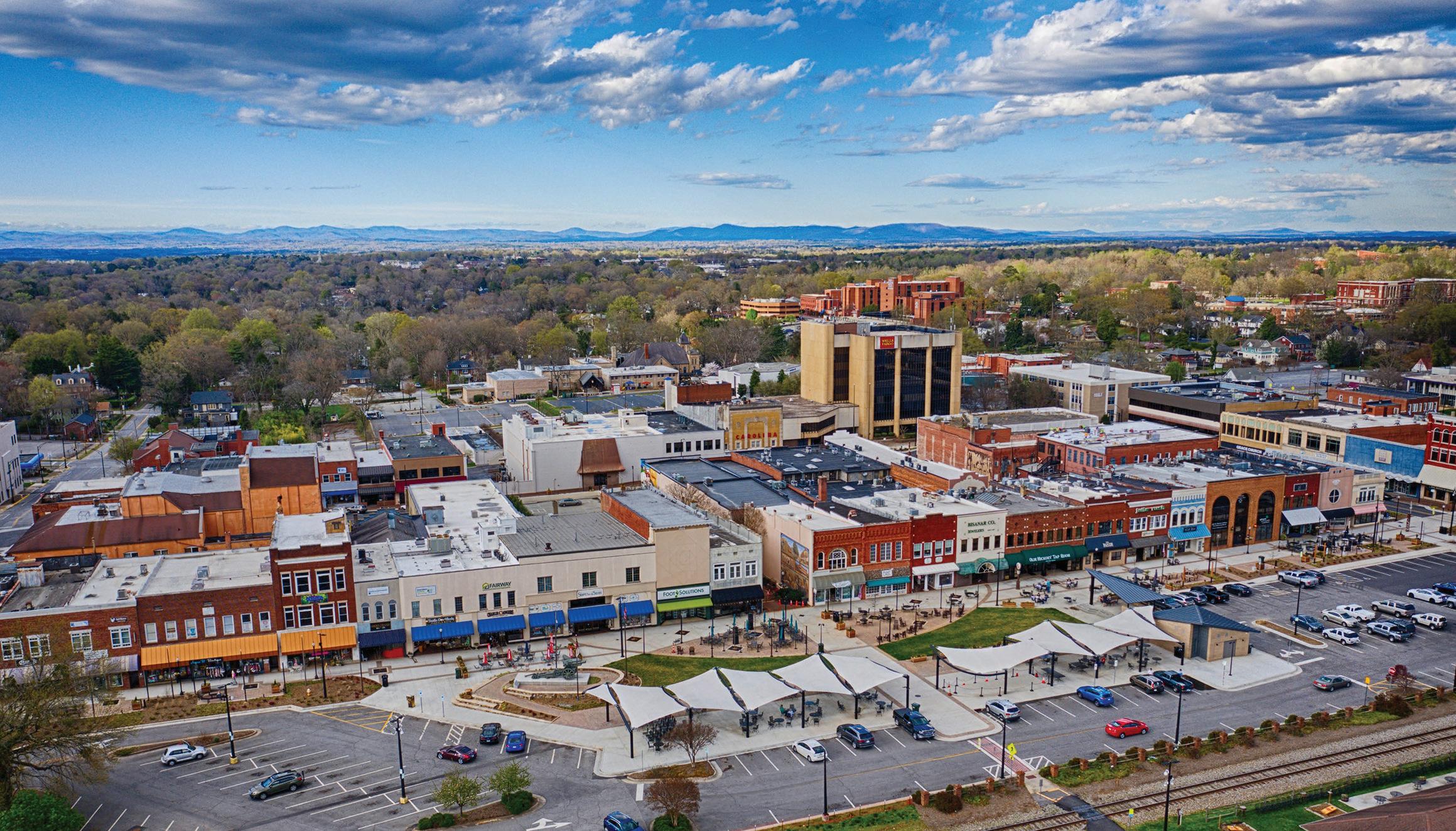
Employers are lured by a strong existing workforce and a quality can also attract employees from outside the area.
Pratt & Whitney, a division of Raytheon Technologies, chose Buncombe County for its new $650-million aircra component manufacturing plant. e recently opened facility makes jet engine fan blades and will employ about 800 people when it’s fully sta ed. Salaries average $68,000 a year. Biltmore Farms sold 100 acres to Pratt & Whitney for $1.
“Given the number of high-paying jobs and capital investment, we believe this project will bene t the families of western North Carolina for generations to come,” says Biltmore Farms President and CEO John “Jack” Cecil. e new positions aren’t just jobs, they are careers, Teague points out.
“ ere has to be that ability for someone to get on the career ladder,” he says. “And if the rungs are close enough, they can climb. But when you get on the career ladder and have to leave because you can’t get to the next rung, something’s broken.
“Pratt & Whitney is an ideal career-ladder employer. ey will take you out of high school and pay for the skills training all the way up to where you have a six- gure [salary] job. When
you can easily see the next rung and make it there, and have that pathway, that’s called economic hope. e average wage [for a machine operator] is $70,000-plus a year. Not only do you have a de ned career ladder, but they pay you to move up. ose types of employers are important for our future.”
GE Aviation is another employer boosting the region’s visibility and workforce. In 2014 the company opened a $126 million facility to accommodate production of a revolutionary aircra engine material known as ceramic matrix composite. CMC materials can outperform advanced metallic alloys, make jet engines lighter and more fuel e cient, and cut emissions dramatically. e Asheville plant is the rst highvolume production facility of CMC materials in the world.
In 2018, the company announced plans to invest another $105 million in its Asheville operations, adding 131 new positions that pay 30% above the Buncombe County average wage and will increase the total workforce to 425.
Hickory, in Catawba County, is a leading hub for furniture making. is longtime North Carolina specialty carries on with state-of-the-art technology. Hickory Springs Manufacturing and Sherrill Furniture each employ more than 1,000 people while many other businesses in the furniture industry employ 100 to 500.
Lowe’s and Amazon have also invested in Western North Carolina. Each company has opened a distribution center of about 100,000 square feet in the past few years, adding to the area’s diversity of employers.
Employers have a steady stream of college graduates and skilled potential employees graduating from more than 20 universities, colleges and technical schools throughout the western region. Through workforce development initiatives at Western Carolina University in Cullowhee, UNC Asheville, Appalachian State University in Boone and other highereducation institutions across the region, residents can prepare for well-paying employment that’s close to home.
“Our goal is to ensure that students see a meaningful path to working and living in the region, and they are connected to employer partners throughout their educational experience at Western Carolina University,” says Theresa Cruz Paul, director of WCU’s Center for Career and Professional Development.
WCU’s 2022 Career Fair PLUS+ hosted 150 employers, nonprofits and graduate school representatives. “The [Center for Career and Professional Development] works hard to ensure that each student can pursue their individual career goals in the state of North Carolina and in particular western North Carolina,”
says Rich Price, WCU’s executive director of economic and regional partnerships.
Appalachian State University broke ground on its Innovation District in March. The Conservatory for Biodiversity Education and Research will develop economic opportunities across the region. “[It will] serve as a vital link between the campus and the regional community through education, research and outreach,” according to a university press release.
“One thing we learned during the pandemic is we don’t want to be over reliant on one particular sector, so I think diversification in growth and looking for opportunities to capitalize on new industries is something we’re looking at and our partners are looking at,” says Scottie Parks, impact officer for economic opportunity at Dogwood Health Trust, a private foundation improving the well-being of the region’s residents and communities.
Dogwood’s Success Coach Partnership with Blue Ridge, Western Piedmont and Asheville-Buncombe Technical community colleges helps students stay on their chosen career tracks.
“[It’s] essentially case workers and counselors for community college students that will ensure that these students have what

they need to complete their credentials,” Parks says. “We had a meeting with community college presidents early in 2021 to hear from them about what challenges they face and what we can do. And Success Coach rose to the top of the conversation, so we felt like we could get those three [colleges] funded, and we hope to engage with some of the others.”
Another example of the community supporting education and careers is the Asheville Area Chamber of Commerce program, Next AVL, named after the airport code for Asheville Regional Airport. The mentorship program matches students from the many colleges and universities with successful business owners or leaders.
“Some of these students may be the first in their family to go to college. We want to connect them to opportunities. The best way to find a job is through connections,” Cramer says. “It helps these young people establish relationships.”
It also encourages graduates to stay in the area where the mentorship and resulting connections can continue.
Other nonprofit organizations invest in the west and partner with schools to enhance education and quality of life.
Gateway Wellness Foundation helps local governments and nonprofits in Burke, McDowell, Polk and Rutherford counties address community needs.
Dogwood Health Trust, formed in 2019 when HCA Healthcare purchased Asheville-based Mission Health, distributes about $75 million in grants annually.
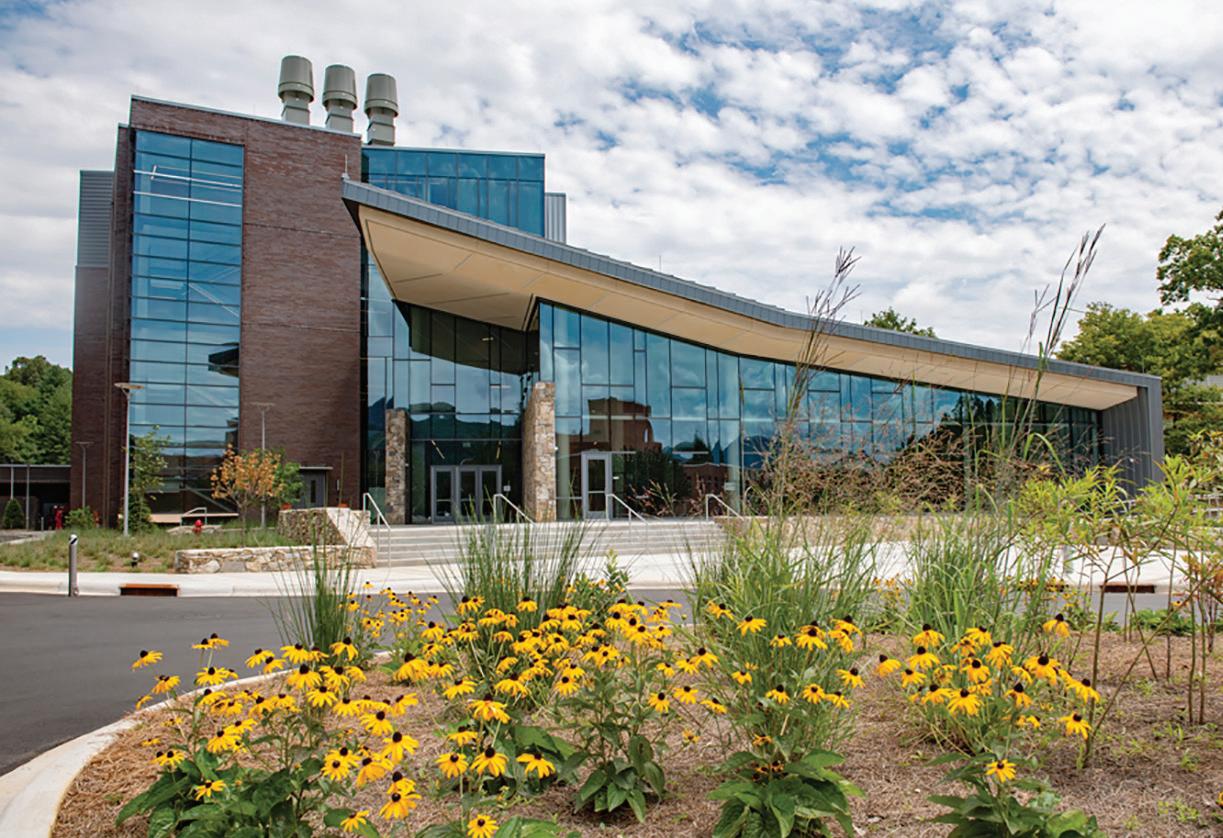


Gateway helps train people to construct modular homes from Kituwah Builders, which is owned by the Eastern Band of Cherokee Indians. Gateway and Dogwood also partner with McDowell Technical Community College’s Construction Trade Skills Academy to prepare students for general construction, construction project management and modular housing.
“[It] not only increases the affordable housing stock and the number of low-income, first-time homeowners, but it also increases the number of trained, certified carpenters and project managers to build the affordable homes,” says Neil Gurney of the Gateway Foundation. “This very technical aspect of the curriculum is coupled with additional courses on employability skills, communication and interpersonal skills. The student is being taught not only how to do the job but how to get the job and how to keep the job.”

The increasing numbers of residents and businesses heightens ongoing demand for housing, road improvements, technology, health care and childcare. Numerous organizations and government entities are accessing and addressing these needs and coming at them in a variety of tactics from small fixes to large undertakings.
The city of Asheville is putting some of its streets on a diet as a way to combat congestion and help businesses. Charlotte Street has undergone a “road diet,” and other busy thoroughfares will also. The process reduces four lanes to three lanes and designates the center one a turn lane going either way.
“You’ve got that turn lane so it doesn’t block traffic behind you,” says Cramer. “It makes room for bike paths and allows broadening of sidewalks. It gives easier access to local retail along the way.”
The road diets are an example of a small initiative compared to the bigger considerations for infrastructure in a comprehensive plan for the next 20 years.
“We are balancing growth with the need for additional housing,” says Cramer. “Are there neighborhoods where they have higher unemployment rates? Can we find land adjacent to that to try to plant a business to be a job provider and simplify transportation issues?”
Government entities will provide incentives for businesses to invest in real estate in these areas.
“We are doing it in collaboration with surrounding counties,” says Cramer. “They have areas ripe for potential new development or redevelopment.”
Bowen National Research conducted a study on housing needs and supply throughout the western region in 2020. The six-month study examined population trends, income expectations, and supply and affordability for home ownership and rentals. It detailed the hourly wage needed to afford a two-bedroom rental unit in each county.
That amount ranged from $12.90 in Graham, McDowell, Mitchell, Rutherford, Swain and Yancey counties to $24.13 in Buncombe, Henderson and Madison counties. According to Asheville-based sustainable economy advocate Just Economics, the 2022 living wage — the minimum needed to meet basic needs — was $17.70 per hour in Buncombe County. It’s $13 in rural regions.
The housing study, funded by Dogwood Health Trust, clearly
With a lack of housing, only about 13% of the 12,000 people employed in Boone as of 2018 lived within the city limits.
concluded there’s a housing shortage in western North Carolina, much like in the rest of the state and country.
The Bowen Research study on housing, is a first step to creating more homes.
“While some of the need is for market-rate homes, much of our housing shortage falls in the areas of transitional, supportive or affordable housing,” says Sarah Grymes, Dogwood’s vice president of impact. “Forming partnerships and leveraging other sources of revenue are going to be key to creating more safe and stable housing.”
With Dogwood’s backing, Gateway Wellness Foundation is building 31 affordable single-family homes in a Rutherfordton development that also will have 60 multifamily units and an Early Head Start location, which will support families and young children. Gateway also plans 26 affordable single-family homes in Marion.
Along with working to expand housing, child care, transportation and health care, Dogwood is improving broadband internet. It has partnered with the Institute for Emerging Issues at N.C. State University to fund the planning grants for all 18 counties and the Qualla Boundary so each will receive a $75,000 grant for broadband.
A recent Appalachian Regional Commission study found 22% of homes in western North Carolina lack broadband access, a deficiency highlighted by remote learning and work during the pandemic.
“We’re focused largely on filling needs that will remove barriers,” says Grymes.



Job Development Investment Grants provide performancebased incentives directly to new and expanding businesses. ey help o set the cost of establishing or expanding in the state.

e One North Carolina Fund awards cash grants based on the number of jobs created, investment made, location selected and economic impact projected.



In 2018, legislators approved a Transformative Project provision of the JDIG grant program. To qualify, companies must create at least 3,000 jobs and invest at least $1 billion within 10 years.
Building Demolition and Building Reuse grants provide funds for site rehabilitation and renovation of vacant industrial and commercial buildings.
North Carolina annually assesses the economic health of its 100 counties. Each is assigned to one of three tiers. Projects in the 40 most distressed counties — Tier 1 — for example, are eligible for greater tax credits than those in the 20 least distressed, Tier 3.
source: North Carolina Department of Commerce


From a homegrown semiconductor maker to a Vietnamese car manufacturer, companies near and far decided last year to expand in North Carolina. These are some of the biggest announcements.
HANOI, VIETNAM
NEW JOBS: 7,500 COUNTY: CHATHAM
PROJECTED INVESTMENT: $4 BILLION
N.C. INCENTIVES: $316.1 MILLION OVER 32 YEARS

North Carolina’s decades-long quest for an automobile assembly plant came to fruition with a March announcement by VinFast, part of the Vingroup conglomerate founded by billionaire Pham Nhat Vuong. e company, which delivered its rst electric vehicles in Vietnam in December 2021, says it will start assembling vehicles in Chatham County’s Moncure community in July 2024. Total state and local investment, including roads and utilities around the plant, could top $850 million if VinFast meets its targets for jobs and investment. e 2,150-acre Triangle Innovation Point was among 29 sites in 29 states that VinFast o cials considered before narrowing their search to Moncure and Savannah, Georgia. Founded in 2017, the company intends to make electric SUV models expected to trade for more than $40,000.
NEW YORK CITY
NEW JOBS: 2,800 COUNTY: ROWAN

PROJECTED INVESTMENT: $584 MILLION
N.C. INCENTIVES: $2.3 MILLION OVER 12 YEARS
By mid-2024, China Grove is expected to be the home of a 1.4 million-square-foot ful llment center that will serve customers of the storied American retailer. e site is slated to account for 30% of Macy’s digital supply-chain capacity. Online sales make up about a third of sales at the company, which operates about 725 stores. New Jersey-based Silverman Group is collaborating with real estate advisory rm Avison Young in developing the property at the 85 North Logistics Center. Macy’s executives cited the region’s strong labor market and highway network as the factors leading them to Rowan County.
DURHAM
NEW JOBS: 1,800
COUNTY: CHATHAM
PROJECTED INVESTMENT: $5 BILLION N.C. INCENTIVES: $86 MILLION OVER 20 YEARS
Durham-based chip maker Wolfspeed’s investment in this new facility stands to be the largest in the state’s history. It plans to create 1,800 jobs paying an average of $77,753 by 2030 for its new semiconductor factory. e facility at Chatham Advanced Manufacturing site near Siler City will enable Wolfspeed, formerly Cree, to increase its capacity tenfold. Construction of the rst phase should be completed in 2024. Wolfspeed will add capacity as needed, eventually occupying more than a million square feet on 445 acres. Wolfspeed is a leading producer of silicon carbide wafers, which are largely used to power smartphones and electric vehicles.

AICHI, JAPAN
NEW JOBS: 2,100 COUNTY: RANDOLPH
PROJECTED INVESTMENT: $3.5 BILLION N.C. INCENTIVES: $315 MILLION OVER 20 YEARS
Toyota’s rst North American battery plant will support the company’s 10 U.S. automotive assembly sites, while providing a high-pro le jolt to the Triad’s reputation as a manufacturing center. Expected to begin operating in 2025, the site will initially feature four production lines, with two more anticipated later. Average salaries are likely to top $62,000. Each line will deliver enough lithium-ion batteries to power 200,000 vehicles. Access to renewable energy was among the factors leading the Japanese automaker to the Greensboro-Randolph Megasite. Electric and hybrid vehicles currently comprise 25% of Toyota’s sales, a number the company hopes to increase to 70% by 2030.
DENVER, COLORADO
NEW JOBS: 1,750 COUNTY: GUILFORD
PROJECTED INVESTMENT: $500 MILLION N.C. INCENTIVES: $87.2 MILLION OVER 20 YEARS


Gov. Roy Cooper described the company’s choice of Piedmont Triad International Airport for a manufacturing site “both poetic and logical” given North Carolina’s history as the birthplace of ight. e company aims to shake up the commercial aviation industry with its Overture jet expected to y at twice the speed of sound while burning sustainable aviation fuels. e company’s factory will span 400,000 square feet and be LEED-certi ed. Boom says it plans to begin production in 2024, with test ights by 2026.

BELLEVUE, WASHINGTON
NEW JOBS: 850 COUNTY: ALAMANCE, CUMBERLAND, JOHNSTON AND PENDER
PROJECTED INVESTMENT: $200 MILLION N.C. INCENTIVES: NONE
E-commerce giant Amazon employs 27,000 North Carolina workers and has invested $5 billion at more than 25 Tar Heel operations. It’s quickly become among the state’s biggest employers over the past few years. Amazon typically doesn’t seek state incentives, but it bene ts from local support in some cases. For example, its 1 million- square-foot warehouse at Fayetteville’s Military Business Park, expected to open late this year, is receiving $2.5 million in incentives from county and city governments. Another 620,000-square-foot center with an expected 500 jobs is being built in Smith eld in Johnston County.



















UNC GREENSBORO GREENSBORO uncg.edu
APPALACHIAN STATE UNIVERSITY BOONE appstate.edu
EAST CAROLINA UNIVERSITY GREENVILLE ecu.edu
ELIZABETH CITY STATE UNIVERSITY ELIZABETH CITY ecsu.edu
FAYETTEVILLE STATE UNIVERSITY FAYETTEVILLE uncfsu.edu
NORTH CAROLINA AGRICULTURAL AND TECHNICAL STATE UNIVERSITY GREENSBORO ncat.edu
NORTH CAROLINA CENTRAL UNIVERSITY DURHAM nccu.edu
NORTH CAROLINA STATE UNIVERSITY RALEIGH ncsu.edu
UNC ASHEVILLE ASHEVILLE unca.edu
UNC CHAPEL HILL CHAPEL HILL unc.edu
UNC CHARLOTTE CHARLOTTE uncc.edu
UNC PEMBROKE PEMBROKE uncp.edu
UNC SCHOOL OF THE ARTS WINSTON-SALEM uncsa.edu
UNC WILMINGTON WILMINGTON uncw.edu
WESTERN CAROLINA UNIVERSITY CULLOWHEE wcu.edu
WINSTON-SALEM STATE UNIVERSITY WINSTON-SALEM wssu.edu
CABARRUS COLLEGE OF HEALTH SCIENCES


CONCORD cabarruscollege.edu

CAMPBELL UNIVERSITY BUIES CREEK campbell.edu
CAROLINA CHRISTIAN COLLEGE WINSTON-SALEM carolina.edu
CAROLINA COLLEGE OF BIBLICAL STUDIES FAYETTEVILLE ccbs.edu
CAROLINA UNIVERSITY WINSTON-SALEM carolinau.edu
CATAWBA COLLEGE SALISBURY catawba.edu
CHAMBERLAIN UNIVERSITY NORTH CAROLINA CHARLOTTE chamberlain.edu
CHARLOTTE CHRISTIAN COLLEGE AND THEOLOGICAL SEMINARY CHARLOTTE charlottechristian.edu
BARTON COLLEGE WILSON barton.edu
BELMONT ABBEY COLLEGE BELMONT belmontabbycollege.edu
BENNETT COLLEGE GREENSBORO bennett.edu
BREVARD COLLEGE BREVARD brevard.edu
CHOWAN UNIVERSITY MURFREESBORO chowan.edu
DAVIDSON COLLEGE DAVIDSON davidson.edu
DEVRY UNIVERSITY CHARLOTTE devry.edu
DUKE UNIVERSITY DURHAM duke.edu
ECPI UNIVERSITY CHARLOTTE, GREENSBORO, RALEIGH ecpi.edu
ELON UNIVERSITY ELON elon.edu

GARDNER-WEBB UNIVERSITY BOILING SPRINGS gardner-webb.edu
GREENSBORO COLLEGE GREENSBORO greensboro.edu
GUILFORD COLLEGE GREENSBORO guilford.edu
HERITAGE BIBLE COLLEGE DUNN heritagebiblecollege.edu
HIGH POINT UNIVERSITY HIGH POINT highpoint.edu

JOHNSON & WALES UNIVERSITY CHARLOTTE jwu.edu
JOHNSON C. SMITH UNIVERSITY CHARLOTTE jcsu.edu
LEES-MCRAE COLLEGE BANNER ELK lmc.edu


LENOIR-RHYNE UNIVERSITY ASHEVILLE, HICKORY lr.edu
LIVING ARTS COLLEGE RALEIGH living-art-college.edu
LIVINGSTONE COLLEGE SALISBURY livingstone.edu
LOUISBURG COLLEGE LOUISBURG louisburg.edu
MANNA UNIVERSITY FAYETTEVILLE manna.edu
MARS HILL UNIVERSITY MARS HILL mhu.edu
MEREDITH COLLEGE RALEIGH meredith.edu
METHODIST UNIVERSITY FAYETTEVILLE methodist.edu
MID-ATLANTIC CHRISTIAN UNIVERSITY ELIZABETH CITY macuniversity.edu
MILLER-MOTTE COLLEGE FAYETTEVILLE, JACKSONVILLE, RALEIGH, WILMINGTON miller-motte.edu
MONTREAT COLLEGE MONTREAT, BLACK MOUNTAIN montreat.edu
NORTH CAROLINA WESLEYAN COLLEGE ROCKY MOUNT ncwc.edu
NORTHEASTERN UNIVERSITY CHARLOTTE, ONLINE northeastern.edu
PFEIFFER UNIVERSITY MISENHEIMER, CHARLOTTE, RALEIGH, DURHAM pfeiffer.edu
QUEENS UNIVERSITY CHARLOTTE queens.edu
SAINT AUGUSTINE’S UNIVERSITY RALEIGH st-aug.edu
SALEM COLLEGE WINSTON-SALEM salem.edu
SHAW UNIVERSITY RALEIGH shawu.edu
SOUTHEASTERN BAPTIST THEOLOGICAL SEMINARY WAKE FOREST sebts.edu
SOUTHEASTERN FREE WILL BAPTIST BIBLE COLLEGE WENDELL sfwbc.edu
ST. ANDREWS UNIVERSITY LAURINBURG sa.edu
STRAYER UNIVERSITY NORTH CAROLINA CHARLOTTE, CONCORD, GREENSBORO, HUNTERSVILLE, MORRISVILLE, RALEIGH strayeruniversity.edu
UNIVERSITY OF MOUNT OLIVE MOUNT OLIVE, DURHAM, GOLDSBORO, SMITHFIELD omu.edu
WAKE FOREST UNIVERSITY WINSTON-SALEM wfu.edu
WARREN WILSON COLLEGE SWANNANOA warren-wilson.edu
WATTS SCHOOL OF NURSING DURHAM wattsschoolofnursing.org
WESTERN GOVERNORS UNIVERSITY DURHAM, ONLINE wgu.edu/north-carolina
WILLIAM PEACE UNIVERSITY RALEIGH peace.edu
WINGATE UNIVERSITY WINGATE, CHARLOTTE, HENDERSONVILLE wingate.edu

ALAMANCE COMMUNITY COLLEGE BURLINGTON, GRAHAM alamancecc.edu
ASHEVILLE-BUNCOMBE TECHNICAL COMMUNITY COLLEGE ARDEN, ASHEVILLE, CANDLER, MARSHALL, WOODFIN abtech.edu
BEAUFORT COUNTY COMMUNITY COLLEGE WASHINGTON beaufortccc.edu
BLADEN COMMUNITY COLLEGE DUBLIN bladencc.edu
BLUE RIDGE COMMUNITY COLLEGE BREVARD, FLAT ROCK, HENDERSONVILLE blueridge.edu
BRUNSWICK COMMUNITY COLLEGE BOLIVIA, LELAND, SOUTHPORT, SUPPLY brunswickcc.edu
CALDWELL COMMUNITY COLLEGE AND TECHNICAL INSTITUTE BOONE, HUDSON cccti.edu
CAPE FEAR COMMUNITY COLLEGE BURGAW, CASTLE HAYNE, HAMPSTEAD, WILMINGTON cfcc.edu
CARTERET COMMUNITY COLLEGE MOREHEAD CITY carteret.edu
CATAWBA VALLEY COMMUNITY COLLEGE
CONOVER, HICKORY, NEWTON, TAYLORSVILLE cvcc.edu
CENTRAL CAROLINA COMMUNITY COLLEGE
DUNN, LILLINGTON, PITTSBORO, SANFORD, SILER CITY cccc.edu
CENTRAL PIEDMONT COMMUNITY COLLEGE CHARLOTTE, HUNTERSVILLE, MATTHEWS cpcc.edu
CLEVELAND COMMUNITY COLLEGE SHELBY clevelandcc.edu
COASTAL CAROLINA COMMUNITY COLLEGE JACKSONVILLE coastalcarolina.edu
COLLEGE OF THE ALBEMARLE BARCO, EDENTON, ELIZABETH CITY, MANTEO abemarle.edu
CRAVEN COMMUNITY COLLEGE HAVELOCK, NEW BERN cravencc.edu
DAVIDSON-DAVIE COMMUNITY COLLEGE BERMUDA RUN, LEXINGTON, MOCKSVILLE, THOMASVILLE davidsondavie.edu
DURHAM TECHNICAL COMMUNITY COLLEGE DURHAM, HILLSBOROUGH durhamtech.edu
EDGECOMBE COMMUNITY COLLEGE
ROCKY MOUNT, TARBORO edgecombe.edu
FAYETTEVILLE TECHNICAL COMMUNITY COLLEGE

FAYETTEVILLE, FORT BRAGG, SPRING LAKE faytechcc.edu
FORSYTH TECHNICAL COMMUNITY COLLEGE KERNERSVILLE, KING, WALNUT COVE, WINSTON-SALEM forsythtech.edu
GASTON COLLEGE BELMONT, DALLAS, LINCOLNTON gaston.edu
GUILFORD TECHNICAL COMMUNITY COLLEGE COLFAX, GREENSBORO, HIGH POINT, JAMESTOWN gtcc.edu
HALIFAX COMMUNITY COLLEGE WELDON halifaxcc.edu
HAYWOOD COMMUNITY COLLEGE CLYDE haywood.edu
ISOTHERMAL COMMUNITY COLLEGE COLUMBUS, RUTHERFORDTON, SPINDALE isothermal.edu


JAMES SPRUNT COMMUNITY COLLEGE KENANSVILLE jamessprunt.edu
JOHNSTON COMMUNITY COLLEGE CLAYTON, FOUR OAKS, SMITHFIELD johnstoncc.edu
LENOIR COMMUNITY COLLEGE KINSTON, LA GRANGE, PINK HILL, SNOW HILL, TRENTON lenoircc.edu
MARTIN COMMUNITY COLLEGE WILLIAMSTON, WINDSOR martincc.edu
MAYLAND COMMUNITY COLLEGE BURNSVILLE, NEWLAND, SPRUCE PINE mayland.edu
MCDOWELL TECHNICAL COMMUNITY COLLEGE MARION mcdowelltech.edu
MITCHELL COMMUNITY COLLEGE MOORESVILLE, STATESVILLE mitchellcc.edu
MONTGOMERY COMMUNITY COLLEGE TROY montgomery.edu
NASH COMMUNITY COLLEGE ROCKY MOUNT nashcc.edu
PAMLICO COMMUNITY COLLEGE BAYBORO, GRANTSBORO pamlicocc.edu
PIEDMONT COMMUNITY COLLEGE ROXBORO, YANCEYVILLE piedmontcc.edu
PITT COMMUNITY COLLEGE WINTERVILLE pittcc.edu
RANDOLPH COMMUNITY COLLEGE ASHEBORO randolph.edu
RICHMOND COMMUNITY COLLEGE HAMLET, LAURINBURG richmondcc.edu
ROANOKE-CHOWAN COMMUNITY COLLEGE AHOSKIE roanokechowan.edu
ROBESON COMMUNITY COLLEGE LUMBERTON robeson.edu
ROCKINGHAM COMMUNITY COLLEGE WENTWORTH rockinghamcc.edu
ROWAN-CABARRUS COMMUNITY COLLEGE CONCORD, KANNAPOLIS, SALISBURY rccc.edu
SAMPSON COMMUNITY COLLEGE CLINTON sampsoncc.edu
SANDHILLS COMMUNITY COLLEGE PINEHURST, CARTHAGE, RAEFORD, ROBBINS sandhills.edu
SOUTHEASTERN COMMUNITY COLLEGE WHITEVILLE sccnc.edu
SOUTH PIEDMONT COMMUNITY COLLEGE MONROE, POLKTON, WADESBORO spcc.edu
SOUTHWESTERN COMMUNITY COLLEGE SYLVA southwesterncc.edu
STANLY COMMUNITY COLLEGE ALBEMARLE, LOCUST stanly.edu
SURRY COMMUNITY COLLEGE DOBSON, ELKIN, MOUNT AIRY, PILOT MOUNTAIN, YADKINVILLE surry.edu

TRI-COUNTY COMMUNITY COLLEGE MARBLE, MURPHY, ROBBINSVILLE tricountycc.edu
VANCE-GRANVILLE COMMUNITY COLLEGE CREEDMOOR, HENDERSON, LOUISBURG, WARRENTON vgcc.edu

WAKE TECHNICAL COMMUNITY COLLEGE CARY, MORRISVILLE, RALEIGH, WAKE FOREST, WENDELL, ZEBULON waketech.edu

WAYNE COMMUNITY COLLEGE GOLDSBORO waynecc.edu
WESTERN PIEDMONT COMMUNITY COLLEGE MORGANTON wpcc.edu

WILKES COMMUNITY COLLEGE SPARTA, WEST JEFFERSON, WILKESBORO wilkescc.edu
WILSON COMMUNITY COLLEGE WILSON wilsoncc.edu
Business North Carolina’s list of the state’s best hospitals with 50 or more beds examines data compiled from several sources to determine which medical centers provide the best care for their patients.






e rankings are calculated using more than 25 metrics, including information provided by the U.S. Centers for Medicare & Medicaid Services. Patient-satisfaction surveys, as well as infection, readmission and death rates for common procedures, are also taken under consideration.


Other factors include safety report cards by the Washington, D.C.-based nonpro t e LeapfrogGroup, distinction awards from insurer Blue Cross and Blue Shield, and z national performance ratings from U.S. News & World Report.



DUKE UNIVERSITY HOSPITAL

DURHAM


BEDS: 957
2021 RANK: 2

























PRESIDENT: THOMAS OWENS



MOSES H. CONE MEMORIAL HOSPITAL GREENSBORO
BEDS: 529 2021 RANK: T-6



PRESIDENT: PRESTON HAMMOCK


BEDS: 369 2021 RANK: T-13

INTERIM PRESIDENT: DEVDUTTA SANGVAI
















CHAPEL HILL






















BEDS: 929












2021 RANK: T-10











PRESIDENT: JANET HADAR

BEDS: 660 2021 RANK: 1
PRESIDENT: ERNIE BOVIO
BEDS: 726 2021 RANK: T-16
PRESIDENT, CEO: DONALD GINTZIG
CONCORD
BEDS: 457 2021 RANK: T-6
VICE PRESIDENT: ASHA RODRIGUEZ
BEDS: 907
2021 RANK: 12
VICE PRESIDENT: D. CHANNING ROUSH
GASTONIA
BEDS: 435 2021 RANK: 3
PRESIDENT, CEO: CHRIS PEEK
CHARLOTTE
BEDS: 597 2021 RANK: 11
PRESIDENT, COO: SAAD ETHTISHAM
HIGH POINT
BEDS: 351 2021 RANK: T-13
PRESIDENT, CEO: JIM HOEKSTRA
NEW BERN
BEDS: 350 2021 RANK: T-6
PRESIDENT, CEO: MICHAEL SMITH








ASHEVILLE






















BEDS: 730 2021 RANK: T-4
PRESIDENT: CHAD PATRICK
BEDS: 390 2021 RANK: T-4
PRESIDENT: MICKEY FOSTER

BEDS: 355 2021 RANK: T-16
CEO: DENNIS BRUNS



















































WINSTON-SALEM
BEDS: 921 2021 RANK: T-6

PRESIDENT, COO: CHAD SETLIFF

WAKE FOREST BAPTIST MEDICAL CENTER WINSTON-SALEM
BEDS: 885 2021 RANK: 15



CEO: JULIE ANN FREISCHLAG






BEDS: 186 2021 RANK: 19
PRESIDENT: BARBARA GRIFFITH
MATTHEWS
BEDS: 146 2021 RANK: 19
PRESIDENT, COO: JASON BERND
HICKORY
BEDS: 258 2021 RANK: T-23
PRESIDENT, CEO: DENNIS JOHNSON
North Carolina is a great place to do business. But you don’t have to take our word for it. The state’s competitive tax rates, infrastructure, customized workforce development and quality of life are a few of the reasons it consistently ranks as a top state for businesses.
RANK CITY POPULATION 1 CHARLOTTE 903,211 2 RALEIGH 480,419 3 GREENSBORO 304,909 4 DURHAM 294,542 5 WINSTON-SALEM 253,531 6 FAYETTEVILLE 210,089 7 CARY 182,619 8 WILMINGTON 117,247 9 HIGH POINT 115,997 10 CONCORD 105,240 11 ASHEVILLE 96,829 12 GREENVILLE 88,815 13 GASTONIA 82,145 14 JACKSONVILLE 73,239 15 HUNTERSVILLE 64,296 16 APEX 63,040 17 CHAPEL HILL 62,906 18 BURLINGTON 58,771 19 KANNAPOLIS 55,212 20 ROCKY MOUNT 53,713 21 MOORESVILLE 53,689 22 WAKE FOREST 51,097 23 WILSON 47,587 24 HOLLY SPRINGS 44,555 25 HICKORY 44,186 26 INDIAN TRAIL 41,293 27 FUQUAY-VARINA 37,396 28 SALISBURY 35,916 29 MONROE 34,914 30 GOLDSBORO 33,101 31 CORNELIUS 32,722 32 GARNER 32,241 33 MORRISVILLE 31,840 34 NEW BERN 31,645 35 SANFORD 30,695 36 MATTHEWS 29,883 37 STATESVILLE 29,197 38 CLAYTON 28,345 39 ASHEBORO 27,584 40 THOMASVILLE 27,269 41 MINT HILL 27,196 42 KERNERSVILLE 27,115 43 LELAND 24,784 44 WAXHAW 22,670 45 SHELBY 22,238 46 CLEMMONS 21,671 47 CARRBORO 21,637 48 KNIGHTDALE 21,041 49 HARRISBURG 20,455 50 LEXINGTON 19,772







Alamance Chamber of Commerce
336-228-1338 alamancechamber.com
2011 2021*
POPULATION (000S) 152.1 173.4 EMPLOYMENT (000S) 56.3 59.8 UNEMPLOYMENT RATE 10.7% 4.8% PER CAPITA INCOME (000S) $33.2 $44.0
Alleghany County Chamber of Commerce
336-372-5473 alleghanycountychamber.com
EMPLOYMENT BY INDUSTRY
Health care: 17.2% Retail: 14.9%
LARGEST PRIVATE-SECTOR EMPLOYER Laboratory Corporation of America
LARGEST CITY/TOWN Burlington (part): population 56,391
COUNTY PROPERTY TAX 65.0 cents per $100 value
HIGHER EDUCATION Elon University; Alamance Community College
Alexander County Economic Development Corp. 828-632-1161 alexanderedc.org
2011 2021*
POPULATION (000S) 37.0 36.1 EMPLOYMENT (000S) 8.8 9.2 UNEMPLOYMENT RATE 11.4% 4.2% PER CAPITA INCOME (000S) $28.3 $40.2
EMPLOYMENT BY INDUSTRY
Manufacturing: 41.1% Government: 9.8%
LARGEST PRIVATE-SECTOR EMPLOYER Craftmaster Furniture
LARGEST CITY/TOWN Taylorsville: population 2,323
COUNTY PROPERTY TAX 79.0 cents per $100 value
HIGHER EDUCATION
Catawba County Community College
EMPLOYMENT BY INDUSTRY
Manufacturing: 18.7% Health care: 11.3%
LARGEST PRIVATE-SECTOR EMPLOYER Parkdale Mills
LARGEST CITY/TOWN Sparta: population 1,888
Anson Economic Development Partnership 704-690-4936 ansonedp.com
2011 2021*
POPULATION (000S) 11.0 10.8 EMPLOYMENT (000S) 3.2 3.2 UNEMPLOYMENT RATE 12.4% 4.6% PER CAPITA INCOME (000S) $29.8 $40.6
Ashe County Economic Development 336-846-5501 ashencedc.com
COUNTY PROPERTY TAX 59.7 cents per $100 value
HIGHER EDUCATION Wilkes Community College
2011 2021*
POPULATION (000S) 27.0 26.4 EMPLOYMENT (000S) 7.1 7.2 UNEMPLOYMENT RATE 12.2% 4.0% PER CAPITA INCOME (000S) $29.8 $39.6
Beaufort County Economic Development 252-946-3970 beaufortedc.com
EMPLOYMENT BY INDUSTRY
Retail: 16.3% Health care: 14.7%
LARGEST PRIVATE-SECTOR EMPLOYER American Emergency Vehicles
LARGEST CITY/TOWN Jefferson: population 1,614
COUNTY PROPERTY TAX 51.0 cents per $100 value
HIGHER EDUCATION Wilkes Community College
2011 2021*
POPULATION (000S) 47.6 44.1 EMPLOYMENT (000S) 16.4 16.0
UNEMPLOYMENT RATE 11.5% 4.8%
PER CAPITA INCOME (000S) $34.1 $46.4
EMPLOYMENT BY INDUSTRY
Retail: 12.9% Manufacturing: 13.8%
LARGEST PRIVATE-SECTOR EMPLOYER Nutrien
LARGEST CITY/TOWN Washington: population 9,793
COUNTY PROPERTY TAX 62.5 cents per $100 value
HIGHER EDUCATION Beaufort County Community College
2011 2021*
POPULATION (000S) 26.4 21.9 EMPLOYMENT (000S) 7.5 6.7 UNEMPLOYMENT RATE 12.2% 6.3% PER CAPITA INCOME (000S) $27.1 $38.8
Avery County Economic Development Committee 828-504-2045 averycounty.com/edc
EMPLOYMENT BY INDUSTRY
Manufacturing: 19.8% Government: 15.1%
LARGEST PRIVATE-SECTOR EMPLOYER Peoplease
LARGEST CITY/TOWN Wadesboro: population 4,964





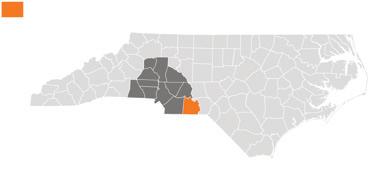

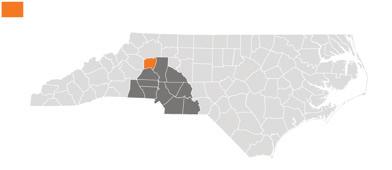
COUNTY PROPERTY TAX 77.7 cents per $100 value
HIGHER EDUCATION
South Piedmont Community College
2011 2021*
POPULATION (000S) 17.9 17.8 EMPLOYMENT (000S) 6.5 6.7 UNEMPLOYMENT RATE 11.6% 3.9% PER CAPITA INCOME (000S) $28.3 $39.4
Bertie County Economic Development 252-794-5301 co.bertie.nc.us
EMPLOYMENT BY INDUSTRY
Retail: 13.0% Government: 13.6%
LARGEST PRIVATE-SECTOR EMPLOYER Sugar Mountain Resort
LARGEST CITY/TOWN Banner Elk: population 1,194
COUNTY PROPERTY TAX 40.0 cents per $100 value
HIGHER EDUCATION
Lees-McRae College; Mayland Community College
EMPLOYMENT BY INDUSTRY
Government: 14.8% Health care: 12.4%
LARGEST PRIVATE-SECTOR EMPLOYER Perdue Farms
LARGEST CITY/TOWN Windsor: 3,253
2011 2021*
POPULATION (000S) 20.8 17.6 EMPLOYMENT (000S) 6.5 5.3 UNEMPLOYMENT RATE 12.7% 5.9%
PER CAPITA INCOME (000S) $27.6 $40.4
COUNTY PROPERTY TAX 86.5 cents per $100 value
HIGHER EDUCATION
Roanoke-Chowan Community College; Martin Community College
Bladen County Economic Development Commission 910-645-2292 bladennc.govoffice3.com
2011 2021*
POPULATION (000S) 34.5 28.8 EMPLOYMENT (000S) 12.4 13.3 UNEMPLOYMENT RATE 13.1% 5.8% PER CAPITA INCOME (000S) $29.8 $39.3
Economic Development Coalition
Asheville-Buncombe County 828-258-6101 ashevillechamber.org/economic-development
EMPLOYMENT BY INDUSTRY
Manufacturing: 45.0% Government: 6.9%
LARGEST PRIVATE-SECTOR EMPLOYER Smithfield Foods
LARGEST CITY/TOWN Elizabethtown: population 3,254
COUNTY PROPERTY TAX 78.5 cents per $100 value
HIGHER EDUCATION Bladen Community College
Brunswick Business and Industry Development 910-408-1603 brunswickbid.com
2011 2021*
POPULATION (000S) 109.3 140.4
EMPLOYMENT (000S) 27.4 35.1 UNEMPLOYMENT RATE 11.5% 6.0%
PER CAPITA INCOME (000S) $33.7 $46.8
EMPLOYMENT BY INDUSTRY
Retail: 17.0% Hospitality: 13.9%
LARGEST PRIVATE-SECTOR EMPLOYER Walmart
LARGEST CITY/TOWN Leland: population 25,459
COUNTY PROPERTY TAX 48.5 cents per $100 value
HIGHER EDUCATION Brunswick Community College
2011 2021*
POPULATION (000S) 242.3 272.9 EMPLOYMENT (000S) 111.1 130.1 UNEMPLOYMENT RATE 8.2% 4.2%
PER CAPITA INCOME (000S) $36.4 $53.3
Cabarrus Economic Development 704-704-703-1725 cabarrusedc.com
EMPLOYMENT BY INDUSTRY
Health care: 18.8% Retail: 13.0%
LARGEST PRIVATE-SECTOR EMPLOYER Mission Health
LARGEST CITY/TOWN Asheville: population 95,052
COUNTY PROPERTY TAX 48.8 cents per $100 value
HIGHER EDUCATION
UNC Asheville; Montreat College; Warren Wilson College; Asheville-Buncombe Technical Community College
EMPLOYMENT BY INDUSTRY
Retail: 15.4% Health care: 12.7%
LARGEST PRIVATE-SECTOR EMPLOYER Atrium Health
LARGEST CITY/TOWN Concord: population 108,229
Burke Development Inc. 828-764-9370 burkedevinc.com
2011 2021*
POPULATION (000S) 89.8 86.8 EMPLOYMENT (000S) 28.2 28.9 UNEMPLOYMENT RATE 12.7% 4.5%
PER CAPITA INCOME (000S) $27.8 $38.9
Economic Development Commission of Caldwell County 828-728-0768 caldwelledc.org
2011 2021*
POPULATION (000S) 181.5 232.1 EMPLOYMENT (000S) 61.2 79.1
UNEMPLOYMENT RATE 10.1% 4.4%
PER CAPITA INCOME (000S) $36.3 $49.7
Camden County Economic Development Commission 252-338-6363 camdencountync.gov
COUNTY PROPERTY TAX 74.0 cents per $100 value
HIGHER EDUCATION
Barber-Scotia College; Rowan-Cabarrus Community College; Cabarrus College of Health Sciences
2011 2021*
POPULATION (000S) 10.0 10.5 EMPLOYMENT (000S) 2.1 1.2
UNEMPLOYMENT RATE 8.5% 3.9%
PER CAPITA INCOME (000S) $39.7 $48.6
EMPLOYMENT BY INDUSTRY
Education: 24.6% Government: 11.0%
LARGEST PRIVATE-SECTOR EMPLOYER Boddie Noell Enterprises Easter Seals UCP North Carolinas
LARGEST CITY/TOWN Elizabeth City (part): population 38
COUNTY PROPERTY TAX 87.0 cents per $100 value
HIGHER EDUCATION College of The Albemarle
2011 2020*
POPULATION (000S) 82.6 80.2 EMPLOYMENT (000S) 24.2 24.4 UNEMPLOYMENT RATE 13.2% 4.9% PER CAPITA INCOME (000S) $27.8 $38.9
Carteret County Economic Development Department 252-648-7880 carteretedc.com
EMPLOYMENT BY INDUSTRY
Health care: 22.7% Manufacturing: 24.1%
LARGEST PRIVATE-SECTOR EMPLOYER Carolinas HealthCare System Blue Ridge
LARGEST CITY/TOWN Morganton: population 17,525
COUNTY PROPERTY TAX 69.5 cents per $100 value
HIGHER EDUCATION
Western Piedmont Community College
EMPLOYMENT BY INDUSTRY
Manufacturing: 23.4% Health care: 14.3%
LARGEST PRIVATE-SECTOR EMPLOYER Merchants Distributors
LARGEST CITY/TOWN Lenoir: population 18,500


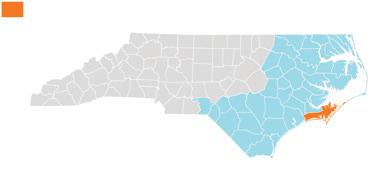




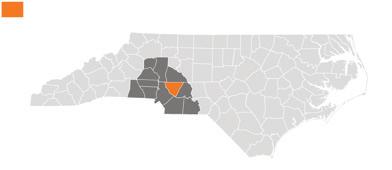
COUNTY PROPERTY TAX 63.0 cents per $100 value
HIGHER EDUCATION
Caldwell Community College and Technical Institute
2011 2021*
POPULATION (000S) 67.4 67.3 EMPLOYMENT (000S) 21.4 23.5
UNEMPLOYMENT RATE 9.4% 4.1%
PER CAPITA INCOME (000S) $40.6 $53.3
EMPLOYMENT BY INDUSTRY
Retail: 18.4% Hospitality: 17.7%
LARGEST PRIVATE-SECTOR EMPLOYER Walmart
LARGEST CITY/TOWN Morehead City: population9,773
COUNTY PROPERTY TAX 33.0 cents per $100 value
HIGHER EDUCATION
Carteret Community College
Caswell County Office of Economic Development 336-933-4674 allincaswellnc.com
2011 2021*
POPULATION (000S) 23.6 22.6 EMPLOYMENT (000S) 3.2 2.8
UNEMPLOYMENT RATE 10.9% 5.3% PER CAPITA INCOME (000S) $27.4 $39.3
Chatham County Economic Development Corp. 919-542-8274 chathamedc.org
EMPLOYMENT BY INDUSTRY
Government: 21.8% Health care: 14.2%
LARGEST PRIVATE-SECTOR EMPLOYER WS Construction
LARGEST CITY/TOWN Yanceyville: population 1,939
COUNTY PROPERTY TAX 73.5 cents per $100 value
HIGHER EDUCATION Piedmont Community College
Catawba County Economic Development Corp. 828-267-1564 catawbaedc.org
2011 2021*
POPULATION (000S) 155.1 161.9
EMPLOYMENT (000S) 78.3 86.2
UNEMPLOYMENT RATE 12.7% 4.7%
PER CAPITA INCOME (000S) $35.4 $49.2
EMPLOYMENT BY INDUSTRY
Manufacturing: 27.4% Retail: 12.6%
LARGEST PRIVATE-SECTOR EMPLOYER Target Stores
LARGEST CITY/TOWN Hickory (part): population 43,960
COUNTY PROPERTY TAX 57.5 cents per $100 value
HIGHER EDUCATION
Lenoir-Rhyne University; Catawba Valley Community College
EMPLOYMENT BY INDUSTRY
Health care: 14.9% Retail: 10.7%
LARGEST PRIVATE-SECTOR EMPLOYER Carolina Meadows
LARGEST CITY/TOWN Siler City: population 7,699
Cherokee County Economic Development 828-835-9564, ext. 204 cherokeecounty-nc.gov
2011 2021*
POPULATION (000S) 64.4 77.7 EMPLOYMENT (000S) 14.1 15.8 UNEMPLOYMENT RATE 8.0% 3.6% PER CAPITA INCOME (000S) $47.1 $66.8
Edenton Chowan Partnership Inc. 252-482-2007 edenton.net
COUNTY PROPERTY TAX 66.5 cents per $100 value
HIGHER EDUCATION Central Carolina Community College
2011 2021*
POPULATION (000S) 14.7 13.6 EMPLOYMENT (000S) 4.6 4.7 UNEMPLOYMENT RATE 11.6% 4.9%
PER CAPITA INCOME (000S) $32.9 $45.4
Cleveland County Economic Development Partnership 704-669-4701
chooseclevelandcountync.com




EMPLOYMENT BY INDUSTRY
Health care: 17.5% Retail: 13.5%
LARGEST PRIVATE-SECTOR EMPLOYER Meherrin Agricultural & Chemical
LARGEST CITY/TOWN Edenton: population 4,476
COUNTY PROPERTY TAX 66.5 cents per $100 value
HIGHER EDUCATION College of The Albemarle
2011 2021*
POPULATION (000S) 97.6 100.5
EMPLOYMENT (000S) 31.8 35.1
UNEMPLOYMENT RATE 11.8% 5.3%
PER CAPITA INCOME (000S) $30.1 $41.6
EMPLOYMENT BY INDUSTRY
Manufacturing: 19.0% Health care: 13.7%
LARGEST PRIVATE-SECTOR EMPLOYER Walmart
LARGEST CITY/TOWN Shelby: population 22,078
COUNTY PROPERTY TAX 68.8 cents per $100 value
HIGHER EDUCATION Gardner-Webb University; Cleveland Community College
2011 2021*
POPULATION (000S) 27.4 28.9 EMPLOYMENT (000S) 7.8 7.7 UNEMPLOYMENT RATE 13.8% 5.0% PER CAPITA INCOME (000S) $27.0 $36.6
Clay County Economic Development 828-389-0089 economic.claync.us
EMPLOYMENT BY INDUSTRY
Retail: 18.3% Health care: 16.7%
LARGEST PRIVATE-SECTOR EMPLOYER Erlanger Western Carolina Hospital
LARGEST CITY/TOWN Andrews: population 1,661
COUNTY PROPERTY TAX 61.0 cents per $100 value
HIGHER EDUCATION Tri-County Community College
2011 2021*
POPULATION (000S) 10.7 11.1 EMPLOYMENT (000S) 1.9 2.0 UNEMPLOYMENT RATE 10.7% 4.9% PER CAPITA INCOME (000S) $27.3 $37.6
Columbus County Economic Development Commission 910-640-6608 columbusedc.com
EMPLOYMENT BY INDUSTRY
Retail: 19.3% Health care: 13.4%
LARGEST PRIVATE-SECTOR EMPLOYER Ingles Markets
LARGEST CITY/TOWN Hayesville: population 466
COUNTY PROPERTY TAX 43.0 cents per $100 value
HIGHER EDUCATION Tri-County Community College
2011 2021*
POPULATION (000S) 57.5 49.3 EMPLOYMENT (000S) 15.3 15.3 UNEMPLOYMENT RATE 13.9% 6.3% PER CAPITA INCOME (000S) $28.2 $37.1
EMPLOYMENT BY INDUSTRY

Health care: 15.5% Retail: 12.4%
LARGEST PRIVATE-SECTOR EMPLOYER Employer HR
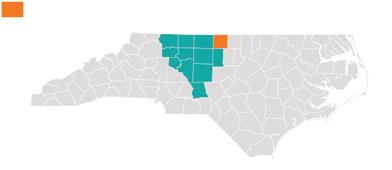
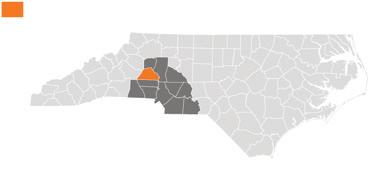

LARGEST CITY/TOWN Whiteville: population 4,705
COUNTY PROPERTY TAX 80.5 cents per $100 value
HIGHER EDUCATION Southeastern Community College
Craven County Economic Development 252-633-5300 cravenbusiness.com
EMPLOYMENT BY INDUSTRY
Government: 17.1% Health care: 17.0%
LARGEST PRIVATE-SECTOR EMPLOYER BSH Home Appliances
LARGEST CITY/TOWN New Bern: population 32,339
Fayetteville Cumberland County Economic Development Corp 910-500-6464 fayedc.com
2011 2021*
POPULATION (000S) 104.3 100.1 EMPLOYMENT (000S) 37.5 39.2 UNEMPLOYMENT RATE 11.0% 4.7% PER CAPITA INCOME (000S) $37.4 $48.8
Currituck County Economic Development 252-232-6015 thinkcurrituck.com
COUNTY PROPERTY TAX 56.0 cents per $100 value
HIGHER EDUCATION Craven Community College
2011 2021*
POPULATION (000S) 23.9 29.3 EMPLOYMENT (000S) 5.3 7.3 UNEMPLOYMENT RATE 7.0% 4.1% PER CAPITA INCOME (000S) $37.4 $49.2
Davidson County Economic Development Commission 336-243-1900 davidsoncountyedc.com
EMPLOYMENT BY INDUSTRY
Retail: 19.7% Hospitality: 11.3%
LARGEST PRIVATE-SECTOR EMPLOYER Vacasa North Carolina
LARGEST CITY/TOWN Myock, unincorporated
COUNTY PROPERTY TAX 46.0 cents per $100 value
HIGHER EDUCATION College of The Albemarle
2011 2021*
POPULATION (000S) 162.9 170.0 EMPLOYMENT (000S) 39.1 44.0
UNEMPLOYMENT RATE 11.6% 4.5% PER CAPITA INCOME (000S) $31.7 $43.3
Duplin County Economic Development Commission 910-296-2180 duplinedc.com
EMPLOYMENT BY INDUSTRY
Manufacturing: 23.5% Retail: 11.9%
LARGEST PRIVATE-SECTOR EMPLOYER Atrium Corp.
LARGEST CITY/TOWN Thomasville (part): population 26,874

COUNTY PROPERTY TAX 54.0 cents per $100 value
HIGHER EDUCATION Davidson County Community College
2011 2021*
POPULATION (000S) 58.1 47.0 EMPLOYMENT (000S) 19.5 18.4
UNEMPLOYMENT RATE 9.8% 4.4%
PER CAPITA INCOME (000S) $29.0 $37.9
EMPLOYMENT BY INDUSTRY
Manufacturing: 29.0% Agriculture: 10.2%
LARGEST PRIVATE-SECTOR EMPLOYER Butterball
LARGEST CITY/TOWN Wallace (part): population 3,439
COUNTY PROPERTY TAX 73.5 cents per $100 value
HIGHER EDUCATION James Sprunt Community College
2011 2021*
POPULATION (000S) 331.1 334.7 EMPLOYMENT (000S) 118.9 118.3 UNEMPLOYMENT RATE 10.2% 6.9%
PER CAPITA INCOME (000S) $33.9 $43.0
The Outer Banks Chamber of Commerce 252-441-8144 outerbankschamber.com
EMPLOYMENT BY INDUSTRY Health care: 18.7% Retail: 14.3%
LARGEST PRIVATE-SECTOR EMPLOYER Walmart
LARGEST CITY/TOWN Fayetteville: population 214,255
COUNTY PROPERTY TAX 79.9 cents per $100 value
HIGHER EDUCATION Methodist University; Fayetteville State University; Fayetteville Technical Community College
EMPLOYMENT BY INDUSTRY
Hospitality: 24.0% Retail: 19.0%
LARGEST PRIVATE-SECTOR EMPLOYER Food Lion
LARGEST CITY/TOWN Kill Devil Hills: population 7,674
2011 2021*
POPULATION (000S) 34.2 37.3 EMPLOYMENT (000S) 18.0 19.2 UNEMPLOYMENT RATE 11.8% 6.0% PER CAPITA INCOME (000S) $42.4 $59.2
Davie County Economic Development Commission 336-751-2714 daviecountyedc.com
COUNTY PROPERTY TAX 40.1 cents per $100 value
HIGHER EDUCATION College of The Albemarle
2011 2021*
POPULATION (000S) 41.2 43.3 EMPLOYMENT (000S) 9.6 12.9 UNEMPLOYMENT RATE 10.2% 4.3% PER CAPITA INCOME (000S) $38.6 $52.2
Greater Durham Chamber of Commerce 919-328-8750 durhamchamber.org
EMPLOYMENT BY INDUSTRY
Manufacturing: 29.1% Retail: 12.5%
LARGEST PRIVATE-SECTOR EMPLOYER Ashley Furniture Industries
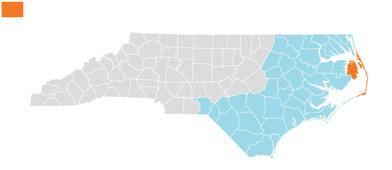



LARGEST CITY/TOWN Mocksville: population 5,991
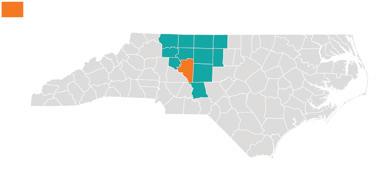


COUNTY PROPERTY TAX 73.3 cents per $100 value
HIGHER EDUCATION Davidson County Community College
2011 2021*
POPULATION (000S) 276.5 330.0 EMPLOYMENT (000S) 179.5 221.8
UNEMPLOYMENT RATE 8.5% 4.1%
PER CAPITA INCOME (000S) $41.0 $54.1
EMPLOYMENT BY INDUSTRY
Health care: 18.1% Professional services: 13.6%
LARGEST PRIVATE-SECTOR EMPLOYER Duke University
LARGEST CITY/TOWN Durham (part): population 286,658
COUNTY PROPERTY TAX 72.2 cents per $100 value
HIGHER EDUCATION
Duke University; NC Central University; Durham Technical Community College
Carolinas Gateway Partnership 252-442-0114 econdev.org
EMPLOYMENT BY INDUSTRY
Retail: 21.1% Manufacturing: 19.1%
LARGEST PRIVATE-SECTOR EMPLOYER QVC
LARGEST CITY/TOWN Rocky Mount (part): population 15,243
Greater Winston-Salem Inc. 336-728-9200 winstonsalem.com
2011 2021*
POPULATION (000S) 55.8 48.1 EMPLOYMENT (000S) 18.2 16.0
UNEMPLOYMENT RATE 15.9% 8.5% PER CAPITA INCOME (000S) $29.6 $39.4
Franklin County Economic Development Commission 919-554-1863 franklincountync.us
COUNTY PROPERTY TAX 95.0 cents per $100 value
HIGHER EDUCATION Edgecombe Community College
2011 2021*
POPULATION (000S) 60.6 70.4 EMPLOYMENT (000S) 11.8 12.3 UNEMPLOYMENT RATE 10.3% 4.7% PER CAPITA INCOME (000S) $29.1 $39.5
Gates County Chamber of Commerce 252-506-1592 gatescountync.gov
EMPLOYMENT BY INDUSTRY
Manufacturing: 22.1% Retail: 11.3%
LARGEST PRIVATE-SECTOR EMPLOYER Novozymes North America
LARGEST CITY/TOWN Louisburg: population 3,075
COUNTY PROPERTY TAX 78.5 cents per $100 value
HIGHER EDUCATION Louisburg College; Vance-Granville Community College
EMPLOYMENT BY INDUSTRY
Retail: 11.6% Government: 10.4%
LARGEST PRIVATE-SECTOR EMPLOYER Ashton Lewis Lumber
LARGEST CITY/TOWN Gatesville: population 264
2011 2021*
POPULATION (000S) 11.9 10.2 EMPLOYMENT (000S) 1.4 1.5 UNEMPLOYMENT RATE 7.8% 4.3% PER CAPITA INCOME (000S) $31.1 $41.6
Granville County Economic Development Commission 919-693-5911 granvillecounty.org
COUNTY PROPERTY TAX 84.0 cents per $100 value
HIGHER EDUCATION College of The Albemarle
2011 2021*
POPULATION (000S) 57.7 61.4 EMPLOYMENT (000S) 19.8 20.3
UNEMPLOYMENT RATE 10.5% 4.0%
PER CAPITA INCOME (000S) $31.3 $42.8
EMPLOYMENT BY INDUSTRY
Health care: 24.2% Manufacturing: 18.5%
LARGEST PRIVATE-SECTOR EMPLOYER Food Lion
LARGEST CITY/TOWN Oxford: population 8,691
COUNTY PROPERTY TAX 84.0 cents per $100 value
HIGHER EDUCATION Vance-Granville Community College
2011 2021*
POPULATION (000S) 354.7 385.5
EMPLOYMENT (000S) 171.1 186.1
UNEMPLOYMENT RATE 10.0% 4.9%
PER CAPITA INCOME (000S) $39.3 $51.3
Gaston County Economic Development Commission 704-825-4046 gaston.org
EMPLOYMENT BY INDUSTRY
Health care: 21.0% Retail: 11.8%
LARGEST PRIVATE-SECTOR EMPLOYER Wake Forest Baptist Medical Center
LARGEST CITY/TOWN
Winston-Salem: population 250,249

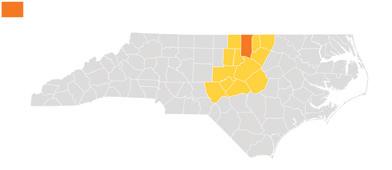
COUNTY PROPERTY TAX 67.8 cents per $100 value
HIGHER EDUCATION
Wake Forest University; Salem College; Winston-Salem State University; UNC School of the Arts; Forsyth Technical Community College
EMPLOYMENT BY INDUSTRY
Manufacturing: 19.2% Health care: 18.0%
LARGEST PRIVATE-SECTOR EMPLOYER Food Lion
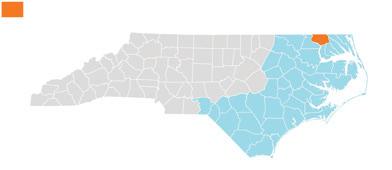
LARGEST CITY/TOWN Gastonia: population 81,558


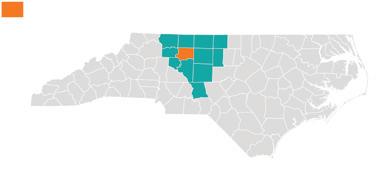


2011 2021*
POPULATION (000S) 207.7 230.4 EMPLOYMENT (000S) 64.9 74.5 UNEMPLOYMENT RATE 11.6% 5.2% PER CAPITA INCOME (000S) $33.6 $44.1
Graham County Economic Development 828-479-7984 grahamcountyedc.org
COUNTY PROPERTY TAX 81.0 cents per $100 value
HIGHER EDUCATION
Belmont Abbey College; Gaston College
EMPLOYMENT BY INDUSTRY
Construction: 19.5% Government: 13.1%
LARGEST PRIVATE-SECTOR EMPLOYER Graham County Land Co.
LARGEST CITY/TOWN Robbinsville: population 600
2011 2021*
POPULATION (000S) 8.8 8.0 EMPLOYMENT (000S) 2.2 2.0 UNEMPLOYMENT RATE 17.0% 6.9%
PER CAPITA INCOME (000S) $27.3 $37.9
Greene County Economic Development Commission 252-747-3446 greenecountync.gov
COUNTY PROPERTY TAX 65.0 cents per $100 value
HIGHER EDUCATION
Tri-County Community College
2011 2021*
POPULATION (000S) 21.4 20.4 EMPLOYMENT (000S) 4.3 4.5
UNEMPLOYMENT RATE 10.7% 4.1%
PER CAPITA INCOME (000S) $26.1 $34.8
EMPLOYMENT BY INDUSTRY
Government: 27.4% Health care: 12.0%
LARGEST PRIVATE-SECTOR EMPLOYER
Greene County Health Care
LARGEST CITY/TOWN
Snow Hill: population 1,468
COUNTY PROPERTY TAX 78.6 cents per $100 value
HIGHER EDUCATION
Lenoir Community College
Greensboro Chamber of Commerce 336-387-8310, greensboro.org High Point Economic Development Corp. 336-883-3116, highpointnc.gov
2011 2021*
POPULATION (000S) 495.4 547.4 EMPLOYMENT (000S) 261.3 278.6 UNEMPLOYMENT RATE 10.8% 5.6% PER CAPITA INCOME (000S) $37.5 $49.9
Harnett County Economic Development Commission 910-893-7524 harnettedc.org
EMPLOYMENT BY INDUSTRY
Health care: 13.1% Manufacturing: 11.2%
LARGEST PRIVATE-SECTOR EMPLOYER Cone Health
LARGEST CITY/TOWN Greensboro: population 299,197
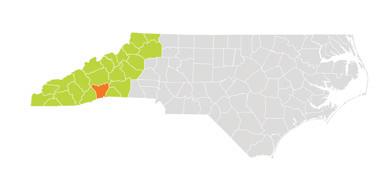
COUNTY PROPERTY TAX 73.1 cents per $100 value
HIGHER EDUCATION
Bennett, Guilford and Greensboro colleges; High Point and NC A&T State universities; UNC Greensboro; Guilford Technical Community College
Halifax County Economic Development Commission 252-519-2630 halifaxdevelopment.com
2011 2021*
POPULATION (000S) 54.0 47.9
EMPLOYMENT (000S) 16.5 14.6 UNEMPLOYMENT RATE 14.1% 7.5%
PER CAPITA INCOME (000S) $30.1 $39.7
EMPLOYMENT BY INDUSTRY
Health care: 16.3% Retail: 15.4%
LARGEST PRIVATE-SECTOR EMPLOYER Resers Fine Foods
LARGEST CITY/TOWN Roanoke Rapids: population 15,097
COUNTY PROPERTY TAX 76.0 cents per $100 value
HIGHER EDUCATION Halifax Community College
2011 2021*
POPULATION (000S) 118.4 134.8 EMPLOYMENT (000S) 21.5 26.0
UNEMPLOYMENT RATE 11.6% 5.3% PER CAPITA INCOME (000S) $29.6 $38.3
Henderson County Partnership for Economic Development 828-692-6373 gohendersoncountync.org
EMPLOYMENT BY INDUSTRY
Retail: 17.6% Health care: 13.6%
LARGEST PRIVATE-SECTOR EMPLOYER Food Lion
LARGEST CITY/TOWN Dunn: population 8,533
COUNTY PROPERTY TAX 59.1 cents per $100 value
HIGHER EDUCATION Campbell University; Central Carolina Community College
EMPLOYMENT BY INDUSTRY
Health care: 18.0% Retail: 14.0%
LARGEST PRIVATE-SECTOR EMPLOYER Ingles Markets
LARGEST CITY/TOWN Hendersonville: population 15,959
Haywood Economic Development Council 828-456-3021 haywoodchamber.com
2011 2021*
POPULATION (000S) 59.0 62.4 EMPLOYMENT (000S) 16.3 17.2 UNEMPLOYMENT RATE 9.9% 4.2% PER CAPITA INCOME (000S) $32.8 $43.8
Hertford County Economic Development 252-358-7801 hertfordcountync.gov
2011 2021*
POPULATION (000S) 107.1 117.4 EMPLOYMENT (000S) 33.8 39.2
UNEMPLOYMENT RATE 8.2% 4.1% PER CAPITA INCOME (000S) $34.6 $47.4
Raeford Hoke Economic Development Commission 910-875-6113 hokecounty.net
COUNTY PROPERTY TAX 56.1 cents per $100 value
HIGHER EDUCATION Blue Ridge Community College
2011 2021*
POPULATION (000S) 48.9 52.3
EMPLOYMENT (000S) 7.8 8.5
UNEMPLOYMENT RATE 9.9% 6.4%
PER CAPITA INCOME (000S) $28.0 $35.4
EMPLOYMENT BY INDUSTRY
Manufacturing: 22.1% Health care: 19.4%
LARGEST PRIVATE-SECTOR EMPLOYER Butterball
LARGEST CITY/TOWN
Raeford: population 4,610
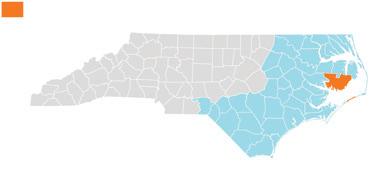


COUNTY PROPERTY TAX 89.5 ncents per $100 value
HIGHER EDUCATION Sandhills Community College
2011 2021*
POPULATION (000S) 24.5 19.9 EMPLOYMENT (000S) 8.8 8.5 UNEMPLOYMENT RATE 11.1% 6.5% PER CAPITA INCOME (000S) $25.7 $36.2
Hyde County Office of Planning and Economic Development 252-926-4178 hydecountync.gov
EMPLOYMENT BY INDUSTRY
Retail: 18.7% Manufacturing: 14.7%
LARGEST PRIVATE-SECTOR EMPLOYER Blue Ridge Paper Products
LARGEST CITY/TOWN Waynesville: population 10,295
COUNTY PROPERTY TAX 53.5 cents per $100 value
HIGHER EDUCATION Haywood Community College
2011 2021*
POPULATION (000S) 5.7 4.5 EMPLOYMENT (000S) 2.1 1.7 UNEMPLOYMENT RATE 10.5% 6.5% PER CAPITA INCOME (000S) $24.5 $42.8

EMPLOYMENT BY INDUSTRY
Health care: 26.6% Retail: 17.6%
LARGEST PRIVATE-SECTOR EMPLOYER Duck Thru
LARGEST CITY/TOWN Ahoskie: population 4,772


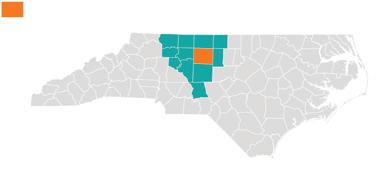
COUNTY PROPERTY TAX 84.0 cents per $100 value
HIGHER EDUCATION Chowan University; Roanoke-Chowan Community College
EMPLOYMENT BY INDUSTRY
Government: 24.1% Hospitality: 14.6%
LARGEST PRIVATE-SECTOR EMPLOYER Illinois Tool Works
LARGEST CITY/TOWN Swan Quarter, unincorporated
COUNTY PROPERTY TAX 89.5 cents per $100 value
HIGHER EDUCATION Beaufort County Community College
Iredell Economic Development Corp. 704-663-1898 iredelledc.com
2011 2021*
POPULATION (000S) 161.3 191.2 EMPLOYMENT (000S) 62.6 77.8
UNEMPLOYMENT RATE 11.3% 4.6% PER CAPITA INCOME (000S) $38.9 $56.2
Johnston County Economic Development 919-205-1232 growwithjoco.com
EMPLOYMENT BY INDUSTRY
Manufacturing: 14.7% Retail: 13.7%
LARGEST PRIVATE-SECTOR EMPLOYER Lowe’s
LARGEST CITY/TOWN Mooresville: population 52,545
COUNTY PROPERTY TAX 53.8 cents per $100 value
HIGHER EDUCATION
Mitchell Community College
Jackson County Office of Economic Development, 828-631-2240 jacksonthrive.jacksonnc.org Jackson County Chamber of Commerce 800-962-1911, mountainlovers.com
2011 2021*
POPULATION (000S) 40.3 43.1 EMPLOYMENT (000S) 12.0 14.1 UNEMPLOYMENT RATE 9.7% 4.5%
PER CAPITA INCOME (000S) $26.7 $38.3
EMPLOYMENT BY INDUSTRY Education: 20.9% Hospitality: 16.5%
LARGEST PRIVATE-SECTOR EMPLOYER DLP Partner Medwest
LARGEST CITY/TOWN Sylva: population 2,473
COUNTY PROPERTY TAX 38.0 cents per $100 value
HIGHER EDUCATION
Western Carolina University; Southwestern Community College
EMPLOYMENT BY INDUSTRY
Retail: 14.3% Manufacturing: 13.9%
LARGEST PRIVATE-SECTOR EMPLOYER Novo Nordisk
LARGEST CITY/TOWN Clayton (part): population 28,188
Jones County Economic Development 252-448-1315 jonescountync.gov
2011 2021*
POPULATION (000S) 172.6 224.0 EMPLOYMENT (000S) 41.7 53.0 UNEMPLOYMENT RATE 9.6% 4.2% PER CAPITA INCOME (000S) $32.8 $44.1
Sanford Area Growth Alliance 919-774-8439 growsanfordnc.com/edc
COUNTY PROPERTY TAX 73.0 cents per $100 value
HIGHER EDUCATION
Johnston Community College
2011 2021*
POPULATION (000S) 58.4 64.3 EMPLOYMENT (000S) 25.0 25.3
UNEMPLOYMENT RATE 12.9% 5.4% PER CAPITA INCOME (000S) $33.4 $44.9
Lincoln Economic Development Association 704-732-1511 lincolneda.org
EMPLOYMENT BY INDUSTRY
Manufacturing: 29.5% Retail: 12.2%
LARGEST PRIVATE-SECTOR EMPLOYER Caterpillar
LARGEST CITY/TOWN Sanford: population 30,762
COUNTY PROPERTY TAX 73.0 cents per $100 value
HIGHER EDUCATION
Central Carolina Community College
2011 2021*
POPULATION (000S) 78.2 88.3 EMPLOYMENT (000S) 19.4 25.0
UNEMPLOYMENT RATE 11.8% 4.1%
PER CAPITA INCOME (000S) $33.5 $50.2
EMPLOYMENT BY INDUSTRY
Manufacturing: 19.8% Retail: 13.8%
LARGEST PRIVATE-SECTOR EMPLOYER RSI Home Products
LARGEST CITY/TOWN Lincolnton: population 11,207
COUNTY PROPERTY TAX 61.9 cents per $100 value
HIGHER EDUCATION Gaston College
2011 2021*
POPULATION (000S) 10.2 8.9 EMPLOYMENT (000S) 1.8 1.6 UNEMPLOYMENT RATE 10.9% 4.2% PER CAPITA INCOME (000S) $34.4 $43.3
Lenoir County Economic Development 252-775-6180 lenoircountync.gov
EMPLOYMENT BY INDUSTRY
Health care: 20.5% Government: 12.4%
LARGEST PRIVATE-SECTOR EMPLOYER Brookstone Living Center
LARGEST CITY/TOWN Maysville: population 818
COUNTY PROPERTY TAX 72.0 cents per $100 value
HIGHER EDUCATION Lenoir Community College
2011 2021*
POPULATION (000S) 59.4 54.8 EMPLOYMENT (000S) 26.4 27.9 UNEMPLOYMENT RATE 11.1% 5.0% PER CAPITA INCOME (000S) $33.2 $44.4
Macon County Economic Development Commission 828-369-2306 maconedc.com
EMPLOYMENT BY INDUSTRY
Manufacturing: 28.7% Health care: 17.1%
LARGEST PRIVATE-SECTOR EMPLOYER Sanderson Farms
LARGEST CITY/TOWN Kinston: population 19,749





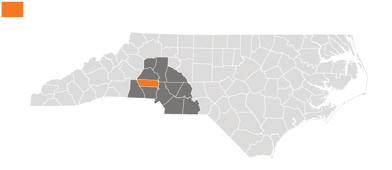

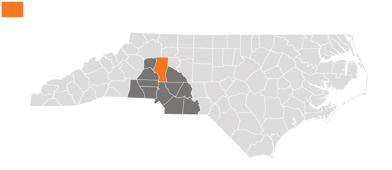
COUNTY PROPERTY TAX 84.5 cents per $100 value
HIGHER EDUCATION Lenoir Community College
2011 2021*
POPULATION (000S) 33.9 37.4 EMPLOYMENT (000S) 10.5 11.3 UNEMPLOYMENT RATE 11.3% 4.2%
PER CAPITA INCOME (000S) $31.8 $44.6
EMPLOYMENT BY INDUSTRY
Retail: 18.6% Hospitality: 15.0%
LARGEST PRIVATE-SECTOR EMPLOYER Drake Enterprises
LARGEST CITY/TOWN Franklin: population 4,216
COUNTY PROPERTY TAX 40.0 cents per $100 value
HIGHER EDUCATION Southwestern Community College
Madison County Economic Development Board 828-649-1377 investinmadison.com
EMPLOYMENT BY INDUSTRY
Health care: 14.0% Government: 13.0%
LARGEST PRIVATE-SECTOR EMPLOYER Ingles Markets
LARGEST CITY/TOWN Mars Hill: population 2,203
Martin County Economic Development Corp. 252-789-4904 martincountyedc.com
2011 2021*
POPULATION (000S) 20.8 21.2 EMPLOYMENT (000S) 4.1 3.9
UNEMPLOYMENT RATE 9.8% 4.3% PER CAPITA INCOME (000S) $27.8 $38.1
McDowell Economic Development Association Inc. 828-652-9391 mcdowellnceda.govoffice3.com
COUNTY PROPERTY TAX 50.0 cents per $100 value
HIGHER EDUCATION
Mars Hill College; Asheville-Buncombe Technical Community College
EMPLOYMENT BY INDUSTRY
Manufacturing: 35.2% Retail: 14.0%
LARGEST PRIVATE-SECTOR EMPLOYER Baxter International
LARGEST CITY/TOWN Marion: population 7,684
2011 2021*
POPULATION (000S) 44.9 44.4 EMPLOYMENT (000S) 14.6 15.5 UNEMPLOYMENT RATE 13.0% 4.5% PER CAPITA INCOME (000S) $27.1 $37.9
Mitchell County Economic Development Commission 828-537-1690 mitchellcountyedc.org
COUNTY PROPERTY TAX 57.8 cents per $100 value
HIGHER EDUCATION
McDowell Technical Community College
EMPLOYMENT BY INDUSTRY
Health care: 17.3% Retail: 14.3%
LARGEST PRIVATE-SECTOR EMPLOYER Sibelco North America
LARGEST CITY/TOWN Spruce Pine: population 2,210
2011 2021*
POPULATION (000S) 15.3 14.8 EMPLOYMENT (000S) 5.0 4.7
UNEMPLOYMENT RATE 11.7% 5.1%
PER CAPITA INCOME (000S) $29.2 $39.5
Moore County Partners in Progress 910-246-0311 moorebusiness.org
COUNTY PROPERTY TAX 56.0 cents per $100 value
HIGHER EDUCATION Mayland Community College
2011 2021*
POPULATION (000S) 89.0 101.6 EMPLOYMENT (000S) 31.0 35.7
UNEMPLOYMENT RATE 9.5% 4.6%
PER CAPITA INCOME (000S) $42.0 $54.5
EMPLOYMENT BY INDUSTRY
Health care: 25.0% Hospitality: 14.3%
LARGEST PRIVATE-SECTOR EMPLOYER FirstHealth of the Carolinas
LARGEST CITY/TOWN Pinehurst: population 18,074
COUNTY PROPERTY TAX 48.5 cents per $100 value
HIGHER EDUCATION Sandhills Community College
2011 2021*
POPULATION (000S) 24.1 21.7
EMPLOYMENT (000S) 7.5 6.2
UNEMPLOYMENT RATE 11.8% 5.5%
PER CAPITA INCOME (000S) $28.8 $38.3
EMPLOYMENT BY INDUSTRY Health care: 15.7% Retail: 16.8%
LARGEST PRIVATE-SECTOR EMPLOYER Snacks Holdings
LARGEST CITY/TOWN Williamston: population 5,151
COUNTY PROPERTY TAX 81.0 cents per $100 value
HIGHER EDUCATION Martin Community College
Charlotte Regional Business Alliance 704-378-1300 charlotteregion.com
2011 2021*
POPULATION (000S) 941.4 1133.5 EMPLOYMENT (000S) 550.8 718.4 UNEMPLOYMENT RATE 10.7% 4.9% PER CAPITA INCOME (000S) $48.3 $65.2
Montgomery County Economic Development 910-576-4221, ext. 1308 montgomerycountync.com
EMPLOYMENT BY INDUSTRY Health care: 11.2% Finance: 11.2%
LARGEST PRIVATE-SECTOR EMPLOYER Wells Fargo Bank
LARGEST CITY/TOWN Charlotte: population 878,778



COUNTY PROPERTY TAX 61.7 cents per $100 value
HIGHER EDUCATION
Davidson College; Johnson C Smith, Johnson & Wales, Pfeiffer and Queens universities; UNC Charlotte; Central Piedmont Community College
EMPLOYMENT BY INDUSTRY
Manufacturing: 32.9% Retail: 10.9%
LARGEST PRIVATE-SECTOR EMPLOYER Jordan Lumber & Supply
LARGEST CITY/TOWN Troy: population 2,848
2011 2021*
POPULATION (000S) 27.6 25.7 EMPLOYMENT (000S) 8.5 8.9 UNEMPLOYMENT RATE 12.6% 4.7%
PER CAPITA INCOME (000S) $26.7 $39.4
Nash County Economic Development 252-462-2737, selectnashnc.com
COUNTY PROPERTY TAX 61.5 cents per $100 value
HIGHER EDUCATION
Montgomery Community College
2011 2021*
POPULATION (000S) 95.7 95.1 EMPLOYMENT (000S) 40.1 38.6
UNEMPLOYMENT RATE 13.0% 6.3%
PER CAPITA INCOME (000S) $34.4 $45.9
EMPLOYMENT BY INDUSTRY
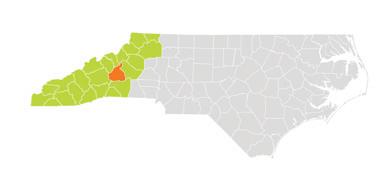
Manufacturing: 18.1% Health care: 13.9%
LARGEST PRIVATE-SECTOR EMPLOYER Hospira
LARGEST CITY/TOWN Rocky Mount (part): population 39,243
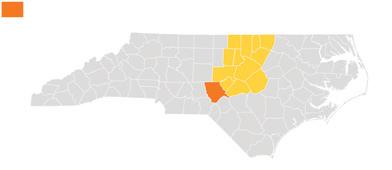



COUNTY PROPERTY TAX 67.0 cents per $100 value
HIGHER EDUCATION
N.C. Wesleyan College; Nash Community College
Wilmington Business Development 910-763-8414 wilmingtonbusinessdevelopment.com
EMPLOYMENT BY INDUSTRY
Health care:16.5% Hospitality: 13.1%
LARGEST PRIVATE-SECTOR EMPLOYER Novant Health New Hanover Regional Medical Center
LARGEST CITY/TOWN Wilmington: population 118,063
Northampton County Economic Development Commission 252-534-1092. ext. 4301 northamptonnc.com
2011 2021*
POPULATION (000S) 205.5 227.8 EMPLOYMENT (000S) 96.9 117.8 UNEMPLOYMENT RATE 9.9% 4.2% PER CAPITA INCOME (000S) $36.8 $50.8
Jacksonville Onslow Economic Development 910-939-7023 joednc.com
COUNTY PROPERTY TAX 45.5 cents per $100 value
HIGHER EDUCATION UNC Wilmington; Cape Fear Community College
EMPLOYMENT BY INDUSTRY
Retail: 21.4% Hospitality: 16.2%
LARGEST PRIVATE-SECTOR EMPLOYER Walmart
LARGEST CITY/TOWN Jacksonville: population 71,729
2011 2021*
POPULATION (000S) 186.4 206.7 EMPLOYMENT (000S) 46.8 50.3 UNEMPLOYMENT RATE 9.1% 5.1% PER CAPITA INCOME (000S) $43.9 $43.1
Pamlico County Office of Economic Development 252-745-3081 pamlicocounty.org
COUNTY PROPERTY TAX 65.5 cents per $100 value
HIGHER EDUCATION
Coastal Carolina Community College
2011 2021*
POPULATION (000S) 13.1 12.1 EMPLOYMENT (000S) 3.1 3.5 UNEMPLOYMENT RATE 10.3% 4.3% PER CAPITA INCOME (000S) $34.5 $46.0
Wilmington Business Development 910-763-8414 wilmingtonbusinessdevelopment.com
EMPLOYMENT BY INDUSTRY
Retail: 15.2% Health care: 15.3%
LARGEST PRIVATE-SECTOR EMPLOYER Capital Area YMCA
LARGEST CITY/TOWN Bayboro: population 1,164
COUNTY PROPERTY TAX 62.5 cents per $100 value
HIGHER EDUCATION Pamlico Community College
2011 2021*
POPULATION (000S) 53.0 61.1
EMPLOYMENT (000S) 9.5 13.6
UNEMPLOYMENT RATE 12.0% 4.2%
PER CAPITA INCOME (000S) $31.1 $41.3
EMPLOYMENT BY INDUSTRY
Retail: 14.2% Health care: 12.4%
LARGEST PRIVATE-SECTOR EMPLOYER Medical Edge Recruitment
LARGEST CITY/TOWN Burgaw: population 4,203
COUNTY PROPERTY TAX 64.5 cents per $100 value
HIGHER EDUCATION Cape Fear Community College
2011 2021*
POPULATION (000S) 21.6 16.8
EMPLOYMENT (000S) 5.0 5.2
UNEMPLOYMENT RATE 12.2% 6.2%
PER CAPITA INCOME (000S) $27.5 $38.4
Orange County Economic Development 919-245-2325 orangecountync.gov
EMPLOYMENT BY INDUSTRY
Wholesale: 14.1% Government: 11.0%
LARGEST PRIVATE-SECTOR EMPLOYER Lowe’s
LARGEST CITY/TOWN Gaston: population 990
COUNTY PROPERTY TAX 90.0 cents per $100 value
HIGHER EDUCATION
Halifax Community College; Roanoke-Chowan Community College
EMPLOYMENT BY INDUSTRY
Education: 28.3% Health care: 26.3%
LARGEST PRIVATE-SECTOR EMPLOYER UNC Healthcare
LARGEST CITY/TOWN
Chapel Hill (part): population 58,904
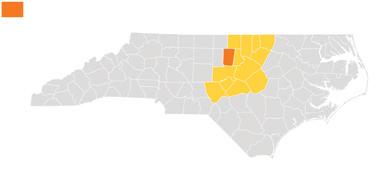


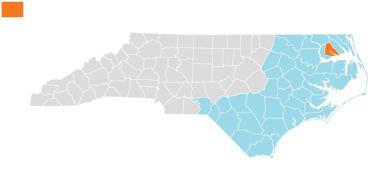
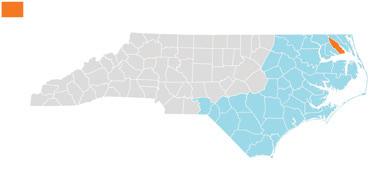


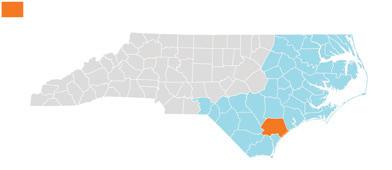
2011 2021*
POPULATION (000S) 135.4 150.3 EMPLOYMENT (000S) 60.9 72.0 UNEMPLOYMENT RATE 6.7% 3.5%
PER CAPITA INCOME (000S) $51.1 $67.1
Elizabeth City Pasquotank County Economic Development Commission 252-338-0169 elizabethcitypasquotankedc.com
COUNTY PROPERTY TAX 83.1 cents per $100 value
HIGHER EDUCATION
UNC Chapel Hill; Durham Technical Community College
EMPLOYMENT BY INDUSTRY
Health care: 18.1% Retail: 16.0%
LARGEST PRIVATE-SECTOR EMPLOYER Sentara Healthcare
LARGEST CITY/TOWN Elizabeth City (part): population 18,923
2011 2021*
POPULATION (000S) 40.2 40.7 EMPLOYMENT (000S) 15.8 15.0 UNEMPLOYMENT RATE 10.8% 5.4%
PER CAPITA INCOME (000S) $32.9 $42.5
Perquimans County Economic Development Commission 252-426-8484 econdevperquimansnc.com
COUNTY PROPERTY TAX 62.0 cents per $100 value
HIGHER EDUCATION
Elizabeth City State University; College of The Albemarle
EMPLOYMENT BY INDUSTRY
Retail: 12.6% Government: 13.8%
LARGEST PRIVATE-SECTOR EMPLOYER FedEx
LARGEST CITY/TOWN Hertford: population 1,973
2011 2021*
POPULATION (000S) 13.5 12.8 EMPLOYMENT (000S) 1.8 2.2 UNEMPLOYMENT RATE 10.4% 5.3%
PER CAPITA INCOME (000S) $34.4 $44.4
COUNTY PROPERTY TAX 61.0 cents per $100 value
HIGHER EDUCATION College of The Albemarle
Person County Economic Development Commission 336-597-1752 personcountyedc.com
2011 2021*
POPULATION (000S) 39.3 39.0 EMPLOYMENT (000S) 9.7 9.5 UNEMPLOYMENT RATE 10.6% 5.0% PER CAPITA INCOME (000S) $30.9 $41.6
Polk County Office of Economic Development 828-894-2895 polkedc.com
EMPLOYMENT BY INDUSTRY
Retail: 18.0% Manufacturing: 14.8%
LARGEST PRIVATE-SECTOR EMPLOYER GKN Automotive Components
LARGEST CITY/TOWN Roxboro: population 8,183
COUNTY PROPERTY TAX 72.0 cents per $100 value
HIGHER EDUCATION Piedmont Community College
Pitt County Economic Development Commission 252-902-2075 locateincarolina.com
2011 2021*
POPULATION (000S) 169.1 170.3
EMPLOYMENT (000S) 69.8 76.3
UNEMPLOYMENT RATE 10.8% 5.0%
PER CAPITA INCOME (000S) $33.1 $45.2
EMPLOYMENT BY INDUSTRY
Health care: 22.7% Education: 13.5%
LARGEST PRIVATE-SECTOR EMPLOYER Patheon Manufacturing Services
LARGEST CITY/TOWN Greenville: population 90,212
COUNTY PROPERTY TAX 68.4 cents per $100 value
HIGHER EDUCATION
East Carolina University; Pitt Community College
EMPLOYMENT BY INDUSTRY
Health care: 27.8% Hospitality: 9.6%
LARGEST PRIVATE-SECTOR EMPLOYER Acts
LARGEST CITY/TOWN Tryon: population 1,564
Randolph County Economic Development Corp. 336-626-2233 rcedc.com
2011 2021*
POPULATION (000S) 20.1 19.0 EMPLOYMENT (000S) 4.7 5.1 UNEMPLOYMENT RATE 8.5% 4.7% PER CAPITA INCOME (000S) $35.3 $48.1
Richmond County Economic Development 910-997-8190 richmondnced.com
COUNTY PROPERTY TAX 51.4 cents per $100 value
HIGHER EDUCATION Isothermal Community College
EMPLOYMENT BY INDUSTRY
Manufacturing: 23.4% Retail: 14.2%
LARGEST PRIVATE-SECTOR EMPLOYER Perdue Farms
LARGEST CITY/TOWN Rockingham: population 9,128
2011 2021*
POPULATION (000S) 46.4 42.5 EMPLOYMENT (000S) 13.6 13.4
UNEMPLOYMENT RATE 13.9% 7.3% PER CAPITA INCOME (000S) $28.0 $38.6
Rockingham County Center for Economic Development, Small Business & Tourism 336-342-8138 rockinghamcountync.gov
COUNTY PROPERTY TAX 83.0 cents per $100 value
HIGHER EDUCATION Richmond Community College
2011 2021*
POPULATION (000S) 93.2 91.1 EMPLOYMENT (000S) 26.4 23.9
UNEMPLOYMENT RATE 12.2% 5.5%
PER CAPITA INCOME (000S) $30.6 $40.7
EMPLOYMENT BY INDUSTRY
Manufacturing: 22.2% Retail: 16.2%
LARGEST PRIVATE-SECTOR EMPLOYER Walmart
LARGEST CITY/TOWN Eden: population 15,379
COUNTY PROPERTY TAX 69.5 cents per $100 value
HIGHER EDUCATION Rockingham Community College
2011 2021*
POPULATION (000S) 141.8 144.8 EMPLOYMENT (000S) 44.6 43.1 UNEMPLOYMENT RATE 10.6% 4.7% PER CAPITA INCOME (000S) $30.4 $41.2
Robeson County Office of Economic Development 910-739-7584 robesoncountyoed.org
EMPLOYMENT BY INDUSTRY
Manufacturing: 32.1% Retail: 10.7%
LARGEST PRIVATE-SECTOR EMPLOYER Technimark
LARGEST CITY/TOWN Asheboro: population 27,473


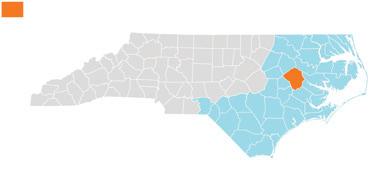



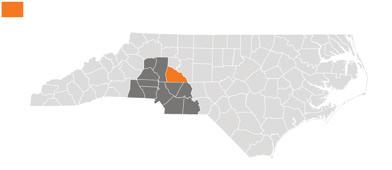

COUNTY PROPERTY TAX 63.3 cents per $100 value
HIGHER EDUCATION Randolph Community College
2011 2021*
POPULATION (000S) 133.0 113.7 EMPLOYMENT (000S) 38.3 37.4 UNEMPLOYMENT RATE 13.9% 7.6% PER CAPITA INCOME (000S) $25.2 $33.1
Rowan EDC Partnership for Economic Development 704-637-5526 rowanedc.com
EMPLOYMENT BY INDUSTRY
Manufacturing: 18.1% Health care: 18.2%
LARGEST PRIVATE-SECTOR EMPLOYER Mountaire Farms
LARGEST CITY/TOWN Lumberton: population 18,896
COUNTY PROPERTY TAX 77.0 cents per $100 value
HIGHER EDUCATION UNC Pembroke; Robeson Community College
EMPLOYMENT BY INDUSTRY
Health care: 15.1% Retail: 13.9%
LARGEST PRIVATE-SECTOR EMPLOYER Food Lion
LARGEST CITY/TOWN Salisbury: population 35,905
2011 2021*
POPULATION (000S) 138.2 147.8 EMPLOYMENT (000S) 44.4 48.6
UNEMPLOYMENT RATE 11.6% 5.0%
PER CAPITA INCOME (000S) $30.6 $43.7
COUNTY PROPERTY TAX 65.8 cents per $100 value
HIGHER EDUCATION Catawba College; Livingstone College; Rowan-Cabarrus Community College
Rutherford County Economic Development 828-287-6200 rutherfordncedc.com
2011 2021*
POPULATION (000S) 67.5 64.2 EMPLOYMENT (000S) 17.7 18.0
UNEMPLOYMENT RATE 14.8% 6.5% PER CAPITA INCOME (000S) $26.9 $36.7
Scotland County Economic Development Corp. 910-266-4326 scotlandcountyedc.org
EMPLOYMENT BY INDUSTRY
Retail: 14.7% Manufacturing: 14.8%
LARGEST PRIVATE-SECTOR EMPLOYER Walmart
LARGEST CITY/TOWN Forest City: population 7,360
COUNTY PROPERTY TAX 59.7 cents per $100 value
HIGHER EDUCATION Isothermal Community College
Sampson County Economic Development Commission 910-592-8921 sampsonedc.com
2011 2021*
POPULATION (000S) 63.2 58.3
EMPLOYMENT (000S) 18.9 17.3
UNEMPLOYMENT RATE 9.0% 4.5%
PER CAPITA INCOME (000S) $31.6 $38.2
EMPLOYMENT BY INDUSTRY
Manufacturing: 16.0% Retail: 13.0%
LARGEST PRIVATE-SECTOR EMPLOYER Smithfield Foods
LARGEST CITY/TOWN Clinton: population 8,375
COUNTY PROPERTY TAX 82.5 cents per $100 value
HIGHER EDUCATION
Sampson Community College
2011 2021*
POPULATION (000S) 36.3 33.7 EMPLOYMENT (000S) 11.9 11.4 UNEMPLOYMENT RATE 17.5% 9.5% PER CAPITA INCOME (000S) $28.5 $36.2
Stokes County Economic Development 336-593-2497 stokesedc.com
EMPLOYMENT BY INDUSTRY
Manufacturing: 20.0% Health care: 18.3%
LARGEST PRIVATE-SECTOR EMPLOYER Scotland Memorial Hospital
LARGEST CITY/TOWN Laurinburg: population 15,035


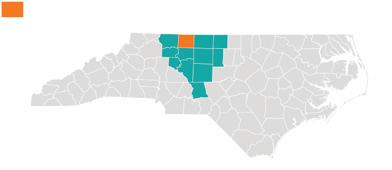



COUNTY PROPERTY TAX 99.0 cents per $100 value
HIGHER EDUCATION St. Andrews University; Richmond Community College
Stanly County Economic Development Commission 704-986-3682 stanlyedc.com
2011 2021*
POPULATION (000S) 60.4 62.2 EMPLOYMENT (000S) 18.0 18.8 UNEMPLOYMENT RATE 11.5% 4.4% PER CAPITA INCOME (000S) $30.0 $42.6
EMPLOYMENT BY INDUSTRY
Manufacturing: 17.9% Retail: 15.4%
LARGEST PRIVATE-SECTOR EMPLOYER Walmart
LARGEST CITY/TOWN Albemarle: population 16,404
COUNTY PROPERTY TAX 61.0 cents per $100 value
HIGHER EDUCATION Pfeiffer University; Stanly Community College
EMPLOYMENT BY INDUSTRY
Retail: 17.6% Education: 13.5%
LARGEST PRIVATE-SECTOR EMPLOYER Walmart
LARGEST CITY/TOWN King (part): population 6,736
Surry County Economic Development Partnership 336-401-9900 surryedp.com
2011 2021*
POPULATION (000S) 47.0 44.3 EMPLOYMENT (000S) 6.8 7.4
UNEMPLOYMENT RATE 9.7% 4.2%
PER CAPITA INCOME (000S) $29.6 $41.2
Swain County Economic Development Commission 828-488-9273 swaincountync.gov
COUNTY PROPERTY TAX 66.0 cents per $100 value
HIGHER EDUCATION Forsyth Technical Community College
EMPLOYMENT BY INDUSTRY
Entertainment: 38.8% Government: 23.1%
LARGEST PRIVATE-SECTOR EMPLOYER Eastern Band of Cherokee Indians
LARGEST CITY/TOWN Bryson City: population 1,556
2011 2021*
POPULATION (000S) 14.2 14.1 EMPLOYMENT (000S) 8.2 10.1
UNEMPLOYMENT RATE 14.8% 4.5%
PER CAPITA INCOME (000S) $30.4 $44.2
COUNTY PROPERTY TAX 36.0 cents per $100 value
HIGHER EDUCATION Southwestern Community College
2011 2021*
POPULATION (000S) 73.3 71.2 EMPLOYMENT (000S) 27.2 27.4 UNEMPLOYMENT RATE 11.3% 4.4%
PER CAPITA INCOME (000S) $30.6 $42.1
EMPLOYMENT BY INDUSTRY
Retail: 14.9% Manufacturing: 14.7%
LARGEST PRIVATE-SECTOR EMPLOYER Pike Electric
LARGEST CITY/TOWN Mount Airy: population 10,609
COUNTY PROPERTY TAX 55.2 cents per $100 value
HIGHER EDUCATION
Surry Community College
Transylvania
Economic Alliance 828-393-4130 transylvaniaalliance.com
2011 2021*
POPULATION (000S) 32.8 32.8 EMPLOYMENT (000S) 8.2 9.2
UNEMPLOYMENT RATE 10.2% 4.1%


PER CAPITA INCOME (000S) $31.4 $44.7
EMPLOYMENT BY INDUSTRY
Health care: 14.9% Retail: 15.8%
LARGEST PRIVATE-SECTOR EMPLOYER Brevard College
LARGEST CITY/TOWN Brevard: population 7,904
COUNTY PROPERTY TAX 60.3 cents per $100 value
HIGHER EDUCATION
Brevard College; Blue Ridge Community College
Tyrrell County Economic Development 252-796-1371 tyrrellcounty.org
EMPLOYMENT BY INDUSTRY
Government: 20.8% Retail: 12.3%
LARGEST PRIVATE-SECTOR EMPLOYER Capt. Charlie’s Seafood
LARGEST CITY/TOWN Columbia: population 574
Monroe-Union County Economic Development 704-282-5780 developunion.com
2011 2021*
POPULATION (000S) 4.3 3.1 EMPLOYMENT (000S) 1.2 0.9 UNEMPLOYMENT RATE 10.9% 7.0% PER CAPITA INCOME (000S) $25.9 $37.6
Henderson-Vance County Economic Development Corp. 252-492-2094 vancecountyedc.com
COUNTY PROPERTY TAX 95.0 cents per $100 value
HIGHER EDUCATION Beaufort County Community College
2011 2021*
POPULATION (000S) 45.2 42.1 EMPLOYMENT (000S) 14.4 13.9 UNEMPLOYMENT RATE 14.7% 7.9% PER CAPITA INCOME (000S) $30.2 $37.8
Warren County Economic Development Commission 252-257-3115 warrencountync.com
EMPLOYMENT BY INDUSTRY
Retail: 14.7% Health care: 14.0%
LARGEST PRIVATE-SECTOR EMPLOYER Walmart
LARGEST CITY/TOWN Henderson: population 14,757
COUNTY PROPERTY TAX 89.0 cents per $100 value
HIGHER EDUCATION
Vance-Granville Community College
2011 2021*
POPULATION (000S) 20.9 18.3 EMPLOYMENT (000S) 3.4 3.0
UNEMPLOYMENT RATE 13.9% 7.7% PER CAPITA INCOME (000S) $25.0 $33.8
Watauga County Office of Economic Development 828-264-3082 wataugaedc.org
EMPLOYMENT BY INDUSTRY
Government: 22.2% Education: 13.3%
LARGEST PRIVATE-SECTOR EMPLOYER Glen Raven
LARGEST CITY/TOWN Norline: population 926
COUNTY PROPERTY TAX 81.0 cents per $100 value
HIGHER EDUCATION
Vance-Granville Community College
2011 2021*
POPULATION (000S) 51.5 53.6 EMPLOYMENT (000S) 21.2 23.6
UNEMPLOYMENT RATE 9.0% 3.7%
PER CAPITA INCOME (000S) $29.3 $40.2
EMPLOYMENT BY INDUSTRY
Hospitality: 18.2% Retail: 15.9%
LARGEST PRIVATE-SECTOR EMPLOYER Appalachian Regional Healthcare System
LARGEST CITY/TOWN Boone: population 19,676
COUNTY PROPERTY TAX 31.8 cents per $100 value
HIGHER EDUCATION
Appalachian State University; Caldwell Community College and Technical Institute
2011 2021*
POPULATION (000S) 204.3 242.7
EMPLOYMENT (000S) 52.2 65.6
UNEMPLOYMENT RATE 9.3% 3.9%
PER CAPITA INCOME (000S) $38.2 $56.8
Wake County Economic Development 919-664-7000 raleigh-wake.org
EMPLOYMENT BY INDUSTRY
Manufacturing: 17.1% Retail: 12.0%
LARGEST PRIVATE-SECTOR EMPLOYER Tyson Farms
LARGEST CITY/TOWN
Indian Trail: population 41,188
COUNTY PROPERTY TAX 58.8 cents per $100 value
HIGHER EDUCATION
Wingate University; South Piedmont Community College
2011 2021*
POPULATION (000S) 927.1 1156.3 EMPLOYMENT (000S) 442.1 582.1 UNEMPLOYMENT RATE 8.3% 4.0% PER CAPITA INCOME (000S) $47.1 $65.5
Washington County Economic Development 252-793-5823 washconc.org
EMPLOYMENT BY INDUSTRY
Professional services: 11.7% Health care: 11.1%
LARGEST PRIVATE-SECTOR EMPLOYER WakeMed Health & Hospitals
LARGEST CITY/TOWN Raleigh (part): population 470,566
COUNTY PROPERTY TAX 62.0 cents per $100 value
HIGHER EDUCATION
Meredith College; William Peace University; St. Augustine’s University; Shaw University; N.C. State University; Wake Technical Community College
EMPLOYMENT BY INDUSTRY
Manufacturing: 20.1% Health care: 16.2%
LARGEST PRIVATE-SECTOR EMPLOYER Domtar Paper
LARGEST CITY/TOWN Plymouth: population 3,243
2011 2021*
POPULATION (000S) 12.9 10.8 EMPLOYMENT (000S) 3.2 3.1 UNEMPLOYMENT RATE 13.5% 6.9%
PER CAPITA INCOME (000S) $30.4 $39.9
Wayne County Development Alliance 919-731-1503 waynealliance.org
COUNTY PROPERTY TAX 85.0 cents per $100 value
HIGHER EDUCATION
Beaufort County Community College; Martin Community College
EMPLOYMENT BY INDUSTRY
Health care: 17.3% Retail: 15.5%
LARGEST PRIVATE-SECTOR EMPLOYER Wayne Memorial Hospital
LARGEST CITY/TOWN Goldsboro: population 33,723
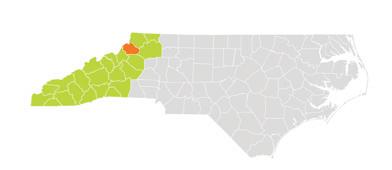

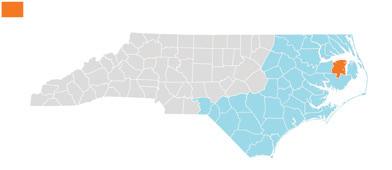

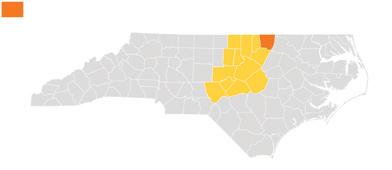
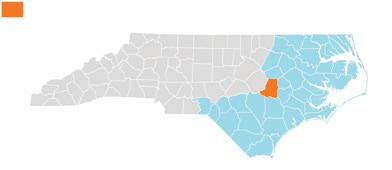

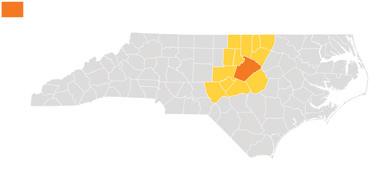
2011 2021*
POPULATION (000S) 123.2 116.1 EMPLOYMENT (000S) 42.8 40.4 UNEMPLOYMENT RATE 9.4% 5.0%
PER CAPITA INCOME (000S) $32.4 $42.9
COUNTY PROPERTY TAX 74.3 cents per $100 value
HIGHER EDUCATION
University of Mount Olive Wayne Community College
Wilkes Economic Development Corp. 336-838-1501 wilkesedc.com
2011 2021*
POPULATION (000S) 68.8 65.4 EMPLOYMENT (000S) 20.9 19.9 UNEMPLOYMENT RATE 12.4% 4.7% PER CAPITA INCOME (000S) $29.1 $39.5
Yadkin County Economic Development Council 336-679-2200 yadkinedc.com
EMPLOYMENT BY INDUSTRY
Manufacturing: 19.0% Retail: 16.6%
LARGEST PRIVATE-SECTOR EMPLOYER Tyson Farms
LARGEST CITY/TOWN North Wilkesboro: population 4,312


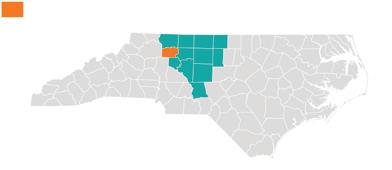

COUNTY PROPERTY TAX 66.0 cents per $100 value
HIGHER EDUCATION Wilkes Community College
Wilson Economic Development Council 252-237-1115 wilsonedc.com
2011 2021*
POPULATION (000S) 80.9 78.3 EMPLOYMENT (000S) 37.1 35.1
UNEMPLOYMENT RATE 13.5% 6.7% PER CAPITA INCOME (000S) $34.2 $43.1
EMPLOYMENT BY INDUSTRY
Manufacturing: 20.4% Health care: 12.4%
LARGEST PRIVATE-SECTOR EMPLOYER Bridgestone Americas
LARGEST CITY/TOWN Wilson: population 48,035
COUNTY PROPERTY TAX 73.0 cents per $100 value
HIGHER EDUCATION Barton College; Wilson Technical Community College
EMPLOYMENT BY INDUSTRY
Manufacturing: 27.5% Transportation: 9.5%
LARGEST PRIVATE-SECTOR EMPLOYER Unifi Manufacturing
LARGEST CITY/TOWN Yadkinville: population 2,986
Yancey County Economic Development Commission 828-682-7722 yanceyedc.org
2011 2021*
POPULATION (000S) 38.3 37.1 EMPLOYMENT (000S) 9.8 9.9 UNEMPLOYMENT RATE 9.8% 4.2% PER CAPITA INCOME (000S) $30.3 $41.3
COUNTY PROPERTY TAX 66.0 cents per $100 value
HIGHER EDUCATION Surry Community College
2011 2021*
POPULATION (000S) 17.8 18.6 EMPLOYMENT (000S) 3.6 4.3
UNEMPLOYMENT RATE 12.0% 4.3%
PER CAPITA INCOME (000S) $29.4 $40.4
EMPLOYMENT BY INDUSTRY
Manufacturing: 25.3% Retail: 14.7%
LARGEST PRIVATE-SECTOR EMPLOYER Altec Industries
LARGEST CITY/TOWN Burnsville: population 1,597
COUNTY PROPERTY TAX 60.0 cents per $100 value
HIGHER EDUCATION Mayland Community College
Population, counties, largest city/town, employment and unemployment rate: N.C. Office of State Budget and Management. Hyde and Currituck counties have no incorporated towns. Employment share by industry sector and largest private-sector employer: N.C. Department of Commerce Labor and Economic Analysis Division, as of fourth quarter of 2021. 2022-23 property-tax rate: N.C. Department of Revenue. Per capita income: U.S. Bureau of Economic Analysis. Community colleges are listed for every county in their designated service area.
*Per capita income is for 2020, the most recent year available.
JANET LABAR, PRESIDENT AND CEO jlabar@charlotteregion.com 330 S. Tryon Street Charlotte, NC 28202 charlotteregion.com | 704-378-1300
Serves Alexander, Cabarrus, Catawba, Cleveland, Gaston, Iredell, Lincoln, Mecklenburg, Rowan, Stanly and Union counties in North Carolina and four South Carolina counties.
CHRISTOPHER CHUNG, CEO clientservices@edpnc.com 150 Fayetteville Street, Suite 1200 Raleigh, NC 27601 edpnc.com | 919-447-7777
Serves the state, working with regional and local partners to help businesses relocate and grow.
125 Bonnie Lane Sylva, NC 28779 gownc.org | 828-586-1962
Serves Cherokee, Clay, Graham, Haywood, Jackson, Macon and Swain counties and Eastern Band of Cherokee Indians.
VANN ROGERSON, PRESIDENT AND CEO rogerson@nceast.org 209 E. Fifth Street Greenville, NC 27858 nceast.org | 252-482-4333
Serves Beaufort, Bertie, Camden, Carteret, Chowan, Craven, Currituck, Dare, Duplin, Edgecombe, Gates, Greene, Halifax, Hertford, Hyde, Jones, Lenoir, Martin, Nash, Northampton, Onslow, Pamlico, Pasquotank, Perquimans, Pitt, Tyrrell, Washington, Wayne and Wilson counties.
NORTH CAROLINA’S SOUTHEAST

STEVE YOST, PRESIDENT locate@ncse.org 707 W. Broad Street, P.O. Box 2556 Elizabethtown, NC 28337 ncse.org | 910-862-8511
Serves Anson, Bladen, Brunswick, Columbus, Craven, Cumberland, Duplin, Hoke, Lenoir, Montgomery, Moore, New Hanover, Onslow, Pender, Robeson, Sampson, Scotland and Wayne counties.
MIKE FOX, PRESIDENT AND CEO info@ptpnc.com
416 Gallimore Dairy Road, Suite M Greensboro, NC 27409 piedmonttriadnc.com | 336-668-4556
Serves Alamance, Caswell, Davidson, Davie, Forsyth, Guilford, Montgomery, Randolph, Rockingham, Stokes, Surry and Yadkin counties.
RYAN COMBS, EXECUTIVE DIRECTOR rcombs@researchtriangle.org P.O. Box 110351
Research Triangle Park, NC 27709 researchtriangle.org | 919-670-2819
Serves Chatham, Durham, Franklin, Granville, Harnett, Johnston, Lee, Nash, Person, Wake, Warren and Wilson counties and Research Triangle Park.
EDPNC BUSINESS / INDUSTRY DEVELOPMENT AND RECRUITMENT
CLIENT SERVICES 919-447-7744 clientservices@edpnc.com edpnc.com
EDPNC EXPORT ASSISTANCE
Mike Hubbard, director of international trade 919-447-7757 mike.hubbard@edpnc.com edpnc.com/start-or-grow-a-business/ export-assistance
EDPNC TOURISM
Wit Tuttell, vice president 919-447-7740 wit.tuttell@visitnc.com visitnc.com
GOLDEN LEAF FOUNDATION
Scott Hamilton, president 252-442-7474 shamilton@goldenleaf.org goldenleaf.org
N.C. DEPARTMENT OF COMMERCE
Susan Fleetwood, executive director of economic development 919-814-4605 sfleetwood@nccommerce.com nccommerce.com
N.C. BOARD OF SCIENCE, TECHNOLOGY & INNOVATION
John Hardin, executive director 919-814-4639 jhardin@nccommerce.com nccommerce.com/sti
NORTH CAROLINA ECONOMIC DEVELOPMENT ASSOCIATION
Liz Dobbins-Smith, managing director 888-246-2332 liz@nceda.org nceda.org
STATE LIBRARY OF NORTH CAROLINA
Susan Forbes, assistant state librarian 919-814-6786 susan.forbes@ncdcr.gov statelibrary.ncdcr.gov
UNC SYSTEM General administration 919-962-1000 northcarolina.edu
N.C. COMMUNITY COLLEGE SYSTEM
Bruce Mack, vice president of economic development 919-807-7150 mackb@nccommunitycolleges.edu nccommunitycolleges.edu
NORTH CAROLINA INDEPENDENT COLLEGES AND UNIVERSITIES

A. Hope Williams, president 919-832-5817 williams@ncicu.org ncicu.org
NORTH CAROLINA ASSOCIATION OF REALTORS
Andrea Bushnell, CEO 336-294-1415 abushnell@ncrealtors.org ncrealtors.org
NORTH CAROLINA LEAGUE OF MUNICIPALITIES
Rose Vaughn Williams, executive director 919-715-3930 nclm.org
NORTH CAROLINA CHAMBER
Gary Salamido, president and CEO 919-836-1403 gsalamido@ncchamber.com ncchamber.com
N.C. STATE PORTS AUTHORITY
Brian Clark, executive director 910-763-1621 brian.clark@ncports.com ncports.com

